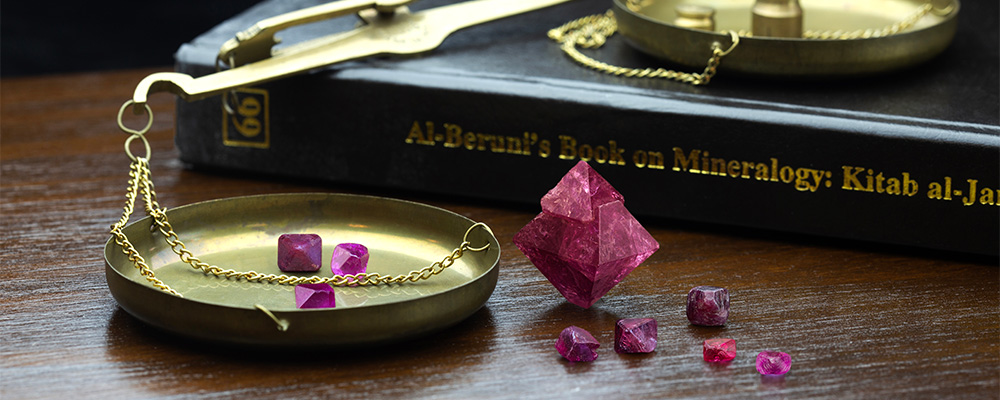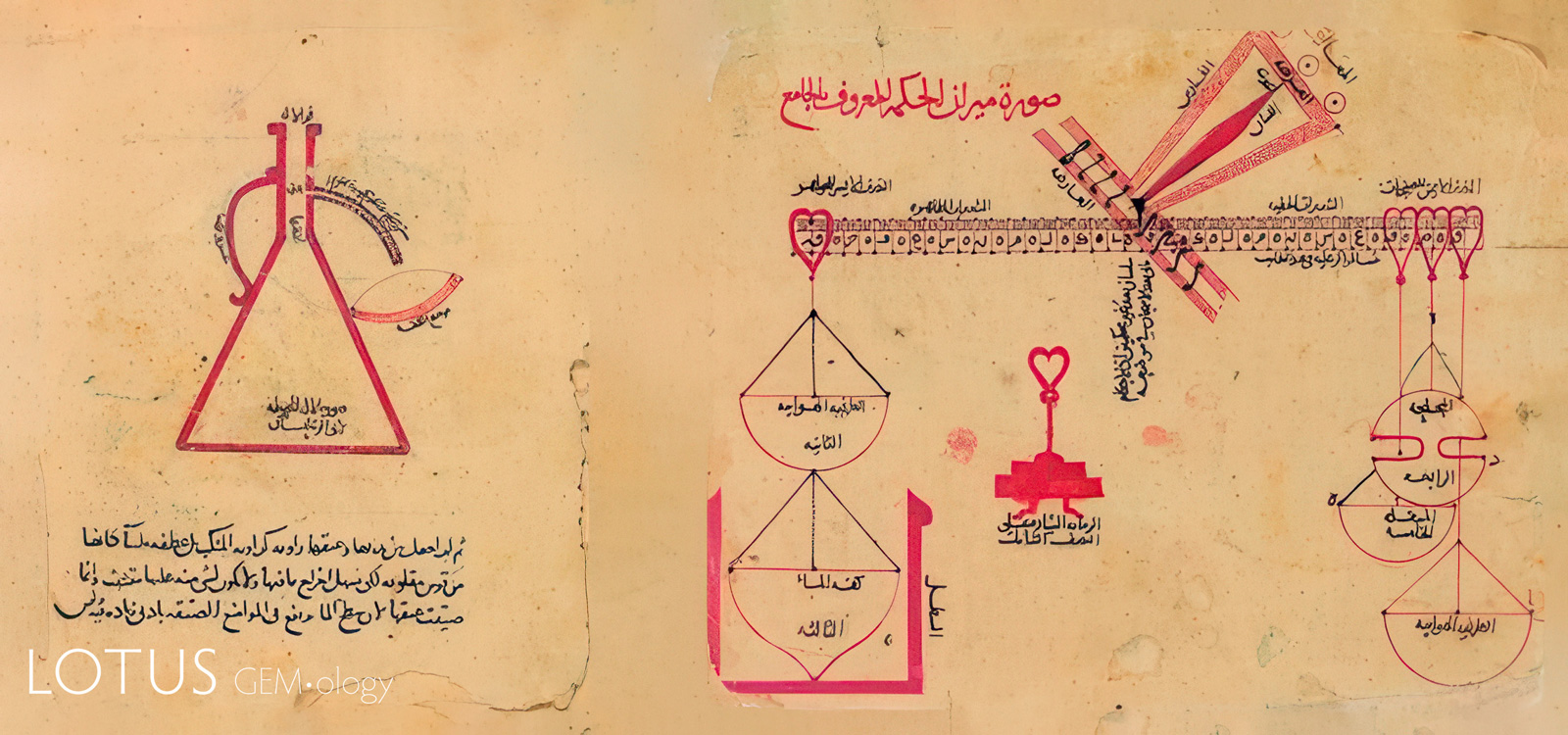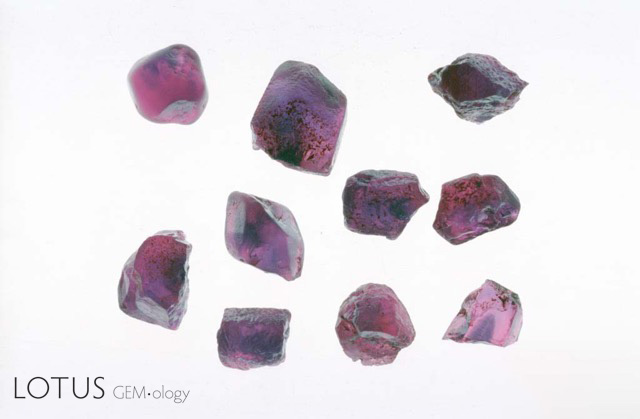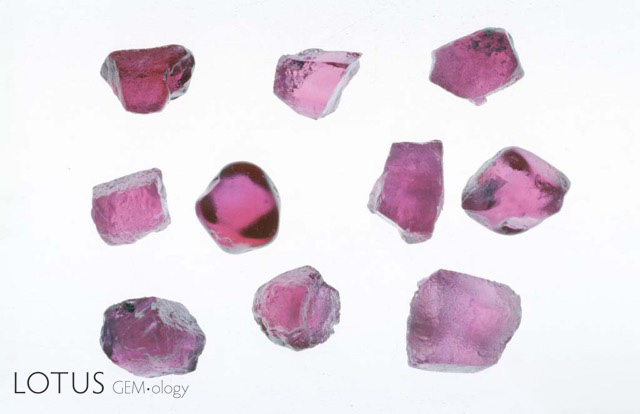Abū Rayḥān Muḥammad ibn Aḥmad al-Bīrūnī was born in 973 CE, in what is now Uzbekistan. A polymath of the Islamic Golden Age, he distinguished himself in numerous fields, including medicine, astronomy, history, mathematics, physics, mineralogy, gemmology, encyclopedism, geography, philosophy, sociology, and travel. His vast intellectual contributions rank him among the greatest minds of any era. The author of some 145 works, tragically, many of these are now lost. Given the sheer scale and depth of his intellectual legacy, any attempt to comprehensively study al-Bīrūnī’s contributions is inevitably limited and fraught with gaps. However, what we do know demonstrates that this was a remarkable man, on the order of an Aristotle or Einstein. And yet much of the world has never even heard of him. This paper will largely focus on his gemmological work, while also touching on his other accomplishments.
Early Life
Al-Bīrūnī was born in 973 CE in Kath [modern name: Beruniy], the capital of the Afrighid Kingdom of Khwarazm in what is today Uzbekistan. He would spend the first 25 years of his life in that city. Orphaned at a young age, he was adopted by a Khwarazm prince and mathematician, Abū Naṣr Manṣūr ibn ʿAlī ibn ʿIrāq al-Jaʿdī (referred to as Abū Naṣr). Al-Bīrūnī exhibited unusual intelligence, beginning his first serious research in physics and astronomy at age 17 (Hamarneh, 1988), calculating both the latitude and longitude of Kath by observing the maximum angle of the sun. His own observations demonstrated to him that the earth was round (Batchelor, 2015).
Born in the Golden Age of Islamic science, during his lifetime, Central Asia was the crossroads of East and West, and al-Bīrūnī benefited greatly from the trade and resulting exchange of ideas that took place because of that fortuitous geography. Several different kingdoms competed in this region over the course of his lifetime (Starr, 2014, 2023).
Following the birth of Islam in 610 CE, Arabs quickly conquered territory ranging from North Africa to the Near East. Finding such disparate lands difficult to govern, Caliph ʿAbd al-Malik ibn Marwān of the Umayyad dynasty (ruled 685–705 CE) replaced the Greek, Persian and Coptic scripts with Arabic in all government documents and currencies, making Arabic the lingua franca of the Islamic world (Crone et al., 1986). This had an incredibly positive impact on the development of science, as suddenly, everyone from Morocco in the West to what is now Pakistan in the East could correspond with one another in a common language (Masood, 2008; Khalili, 2009, 2010).
Almost simultaneously, the “Translation Movement” took hold during the 8–10th centuries. With the example of the destruction of the Great Library of Alexandria (Egypt) around 275 CE, Arabic-language intellectuals understood the fragility of ancient knowledge and thus set about saving whatever they could. Thus was born Baghdad’s Bayt al-Ḥikma or “House of Wisdom” (بيت الحكمة), the centre of a burgeoning movement to translate all great works in philosophy, medicine, astronomy, mathematics, and science. This involved scholars such as Ḥunayn ibn Isḥāq, Thābit ibn Qurra and al-Kindī, the latter of whom we will learn more about later. As academic works in Greek, Persian, Syriac and Sanskrit were rendered into Arabic, this laid the foundation not just for the Islamic Golden Age, but also for the European Renaissance that followed (Masood, 2008; Khalili, 2009, 2010).
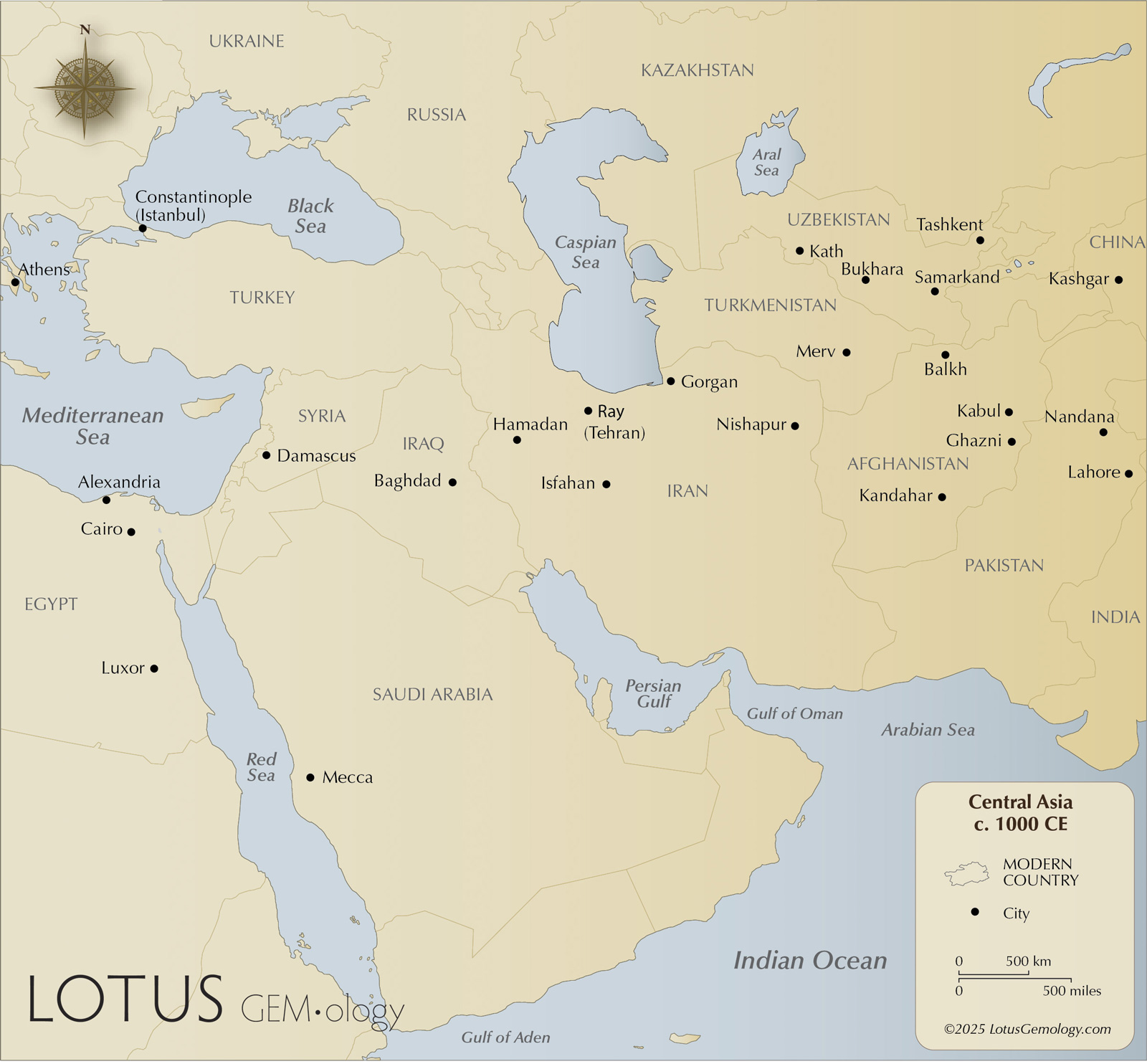 Figure 1. Central Asia in the time of al-Bīrūnī, showing the location of important sites during his life. Al-Bīrūnī was born in 973 CE at Kath, then the capital of Khwarazm in what is now Uzbekistan. He also spent considerable time in Ghazni and what was then India at Lahore. Map: Richard Hughes/Lotusgemology.com
Figure 1. Central Asia in the time of al-Bīrūnī, showing the location of important sites during his life. Al-Bīrūnī was born in 973 CE at Kath, then the capital of Khwarazm in what is now Uzbekistan. He also spent considerable time in Ghazni and what was then India at Lahore. Map: Richard Hughes/Lotusgemology.com
Central Asia in the Time of Al-Bīrūnī
Prior to the arrival of Islam in the early 700s, Central Asia’s religions were Buddhism and Zoroastrianism, along with a smattering of Nestorian Christian, Manichaeism, and others. Far from the monotheist nature of the region today, it was a melting pot of languages, cultures, beliefs, and ideas, the perfect kitchen to cook up scientific innovation, which they did in quantity. In fact, studies have shown that while the famous and noteworthy scholars of Islam’s Golden Age wrote in Arabic, the majority originated from Central Asia (Starr, 2014).
By the time of al-Bīrūnī’s birth, most Central Asian urban centres had been converted to Islam. During his lifetime, kingdoms ebbed and flowed and so followed their retinues of scholars. Not unlike the modern era, during the time of al-Bīrūnī, serious research required money. This limited the field to the rich, or to those who could work under a wealthy benefactor. As he was not personally wealthy, al-Bīrūnī labored under this ancient patronage system,[1] where rulers or select aristocrats would fund libraries and scholars working in fields in both the arts and sciences. The latter obviously included fields with military utility, which were of great importance in a region continually beset by marauding invaders.
Thus, al-Bīrūnī worked under the patronage of several different rulers in several different places across a wide geographic swath over the course of his career. His path led from being championed in one court to being held virtual captive in another (Starr, 2014, 2023).
'The Chronology of Ancient Nations'
When al-Bīrūnī was thirty years old, he completed his first book, The Chronology of Ancient Nations. This was a most unusual tome, with much of it spent describing the customs, holy texts and cultures of everyone from the Egyptians, Greeks, Jews, Persians, Muslims, pre-Muslim Arabs, and much more. He analysed them with a critical eye, going particularly deep into astronomy. Al-Bīrūnī described the Creation according to various religions, then cross-referenced and summarized dates, showing huge discrepancies between the different religions and cultures. This was largely because each had a different way of measuring the passage of time. To fix this, al-Bīrūnī proposed a system that would convert between the dates of different groups. Al-Bīrūnī understood that there can be no decent history without accurate timekeeping. With The Chronology of Ancient Nations, al-Bīrūnī created one of the first “universal histories” (Starr, 2014).
In 1017, Sultan Maḥmūd Subuktigīn, who ruled from Ghazni (eastern Afghanistan), attacked and annexed Kath, causing al-Bīrūnī and his former patron to be dragged off to Ghazni. He later joined Maḥmūd and his armies as they conquered the northern parts of India (now Pakistan) over the period from 1017–1030. Everywhere al-Bīrūnī went, he took detailed astronomical measurements. This would become quite important later, as he developed a new method to measure the earth’s circumference using spherical trigonometry with the law of sines (Batchelor, 2015). His time in India was well spent, not just with astronomy and math, but also in complete cultural immersion.
Measuring Mountains and More
The Greek polymath Eratosthenes of Kyrene (c. 276–c. 194 BCE) was the first to estimate the earth’s circumference by measuring shadows in two different places and noting their angles and the exact distances between the two locations. His estimate was surprisingly good, within two percent of the modern value (Roller, 2010). Obviously, he also knew the earth was round.
Independently, al-Bīrūnī devised a slightly different technique. First, he located a mountain (at Nandana, Pakistan) surrounded by a flat plain. From the plain, he used an astrolabe to measure the angle between the horizon and the top of the mountain. Then he moved to a second location at a carefully measured distance from the first and again measured the angle to the top of the mountain. Following this, he climbed the mountain and measured the angle from the top to the horizon. With these four numbers, plus extremely clever trigonometric calculations, he determined the circumference of the earth to a value quite close to that of Eratosthenes (Batchelor, 2015).
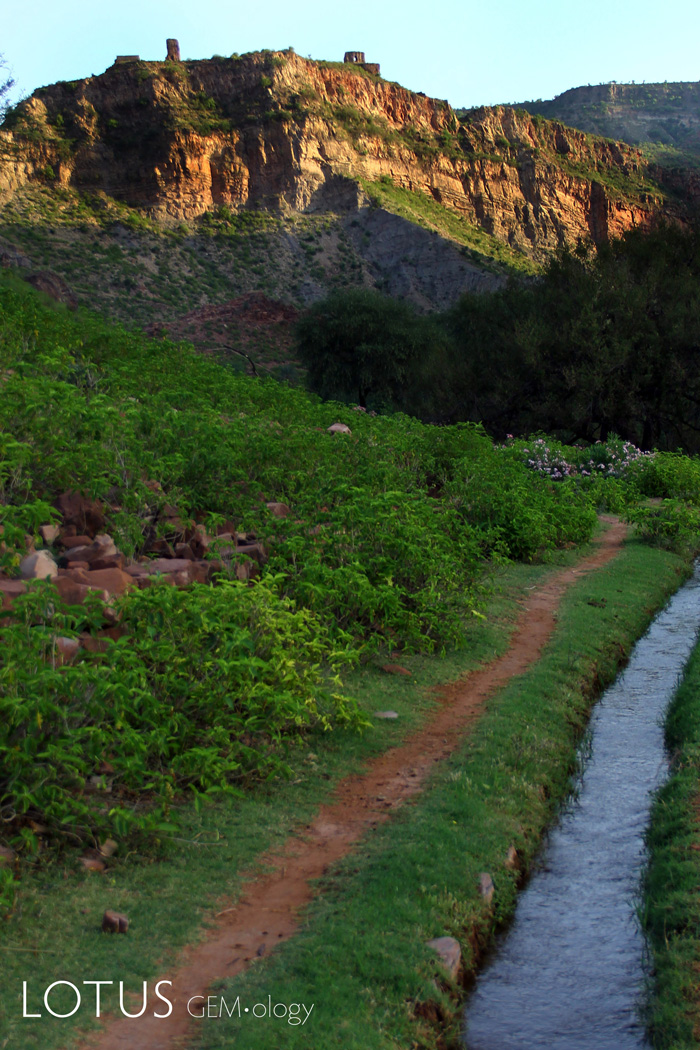 Figure 2. Nandanda Fort in what is now Pakistan atop the mountain from which al-Bīrūnī made measurements to calculate the circumference of the earth in 1017 CE. Photo: Amir Islam, 2014, CC license.
Figure 2. Nandanda Fort in what is now Pakistan atop the mountain from which al-Bīrūnī made measurements to calculate the circumference of the earth in 1017 CE. Photo: Amir Islam, 2014, CC license.
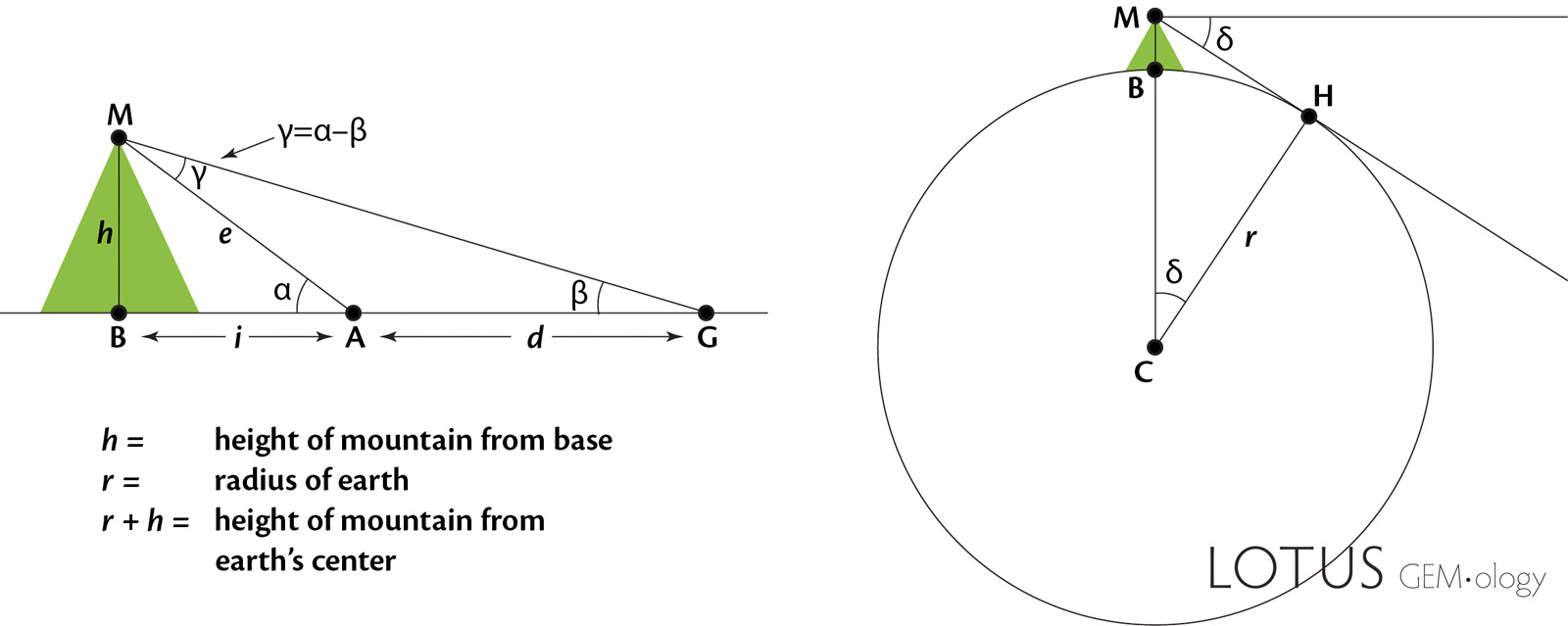 Figure 3. Al-Bīrūnī used trigonometry to measure both the height of a mountain (left) and the radius of the earth (right). The height of the mountain is h (the distance between points M and B). But because point B is at the centre of the mountain’s base, it’s impossible to measure. His solution was to measure the angles α and β from two different points, A and G. He also measured the exact distance between A and G (d). With α, β, and d, he could calculate the height of the mountain from its base (h).
Figure 3. Al-Bīrūnī used trigonometry to measure both the height of a mountain (left) and the radius of the earth (right). The height of the mountain is h (the distance between points M and B). But because point B is at the centre of the mountain’s base, it’s impossible to measure. His solution was to measure the angles α and β from two different points, A and G. He also measured the exact distance between A and G (d). With α, β, and d, he could calculate the height of the mountain from its base (h).
Now, with the mountain height in hand, al-Bīrūnī was able to estimate the size of the earth with just one additional measurement, the dip angle of the horizon (δ) as viewed from the top of the mountain.
This formula gives r, the radius of the earth (based on Lynch, 2021).
India
After some 13 years of research between 1017 and 1030, al-Bīrūnī published Kitab al-Hind or the Book of India,a major ethnographic and scientific study of Indian culture, religions, science, and philosophy. Al-Bīrūnī began his studies of India by teaching himself Sanskrit and then studying various works on all aspects of the subcontinent. In addition to reading India’s Puranas, he also studied secondary sources and developed dialogs with Brahmins and yogis. Although he found animosity in India towards Muslims, he explained that this probably arose because Muslims had so often invaded India. In this sense, he displayed an important tenant of modern anthropology: “relate without criticizing.” The Kitab al-hind was centuries ahead of its time, leading some to label al-Bīrūnī the world’s first anthropologist (Ahmed, 1984).
| Date/Period | Event [a] |
|---|---|
| 570 CE | Muḥammad ibn ʿAbd Allāh, Prophet of Islam, is born in Mecca, in what is now Saudi Arabia. |
| 700–900 | Great Translation Movement centred in Baghdad results in many important antique texts from Greek, Latin, Persian, Syriac, and Indian being translated into Arabic. |
| 700–1000 | Islamic armies spread out from Arabia, gradually taking over North Africa, the Middle East and Central Asia. |
| 973 | Al-Bīrūnī is born at Kath, capital of Khwarazm in what is now Uzbekistan. |
| 995 | He completes his first major work, Al-Athar al-baqiya an al-qurun al-khaliya [The Chronology of Ancient Nations], a comparative study of calendars and ancient cultures. |
| 996 | Due to political instability, he moves to Ray (Tehran) for three years, continuing to work on astronomy. |
| 999–1009 | Al-Bīrūnī shifts to Jurjan (Gorgan, Iran) at the invitation of the local sultan and continues his astronomy work, penning two books. |
| 1009–1017 | Returns to and studies in Khwarazm, a thriving intellectual centre; here, he builds a relationship with ibn Sīnā (Avicenna; the Father of Modern Medicine), who is living in Hamadan in what is now Iran. |
| 1017 | Maḥmūd of Ghazni conquers Khwarazm. Al-Bīrūnī and other scholars are forced by Maḥmūd to accompany his military campaign into India. They later move to Ghazni, capital of Maḥmūd’s empire, and are integrated into his court. |
| 1017 | Al-Bīrūnī calculates the circumference of the earth by measuring the height of a mountain at Nandana Fort in what is now Pakistan. |
| 1017–1030 | Writes Kitāb al-Hind (The Book of India), a major ethnographic and scientific study of Indian culture, religions, science, and philosophy. |
| c. 1025 | Writes Treatise on the Ratios of the Densities of Metals and Gems. |
| 1030 | Maḥmūd of Ghazni dies. |
| 1037 | Al-Bīrūnī publishes the Kitāb al-jamāhir fī maʿrifat al-jawāhir, a book describing gems. |
| 1048 | He completes the Canon Masudicus, a compendium of astronomy and math in which he speculates on the nature of the earth’s surface. |
| 1050 | Al-Bīrūnī passes away in Ghazni at age 77. |
| 1258 | Mongols invade Central Asia, the first step in the destruction of the region’s then-advanced cities and cultures. |
| A. All references are within the main text body | |
'Treatise on the Ratios of the Densities of Metals and Gems'
As was typical during that time, when describing gems and other stones, al-Bīrūnī quotes poets and their descriptions, along with medical uses. He also details the sources from which the stones come. Where he breaks with the past is his actual testing of the properties of gems. Take his analysis of the “weight” of gems. While many earlier authorities realized some gems were “heavier” than others, al-Bīrūnī developed methods of actual measurement based not just on hydrostatic weighing, but also on the volume of fluids and authored an entire book on the subject.
In Maqālah fī al-nisab allatī bayn al-filizzāt wa al-jawāhir fī al-ḥajm [Treatise on the Ratios of the Densities of Metals and Gems], which exists as a single manuscript in St. Joseph University in Beirut (Ansari, 1975), al-Bīrūnī described a unique vessel that could measure the specific gravity of a gem. Using this device, he was able to separate spinel from corundum (ruby/sapphire) a full 800 years before Greville (1798) and Bournon (1798) formally defined the corundum mineral species. We are not aware of any writer on precious stones until Boetius de Boodt in 1609 (who introduced a five-level scale of hardness) who actually made direct measurements.
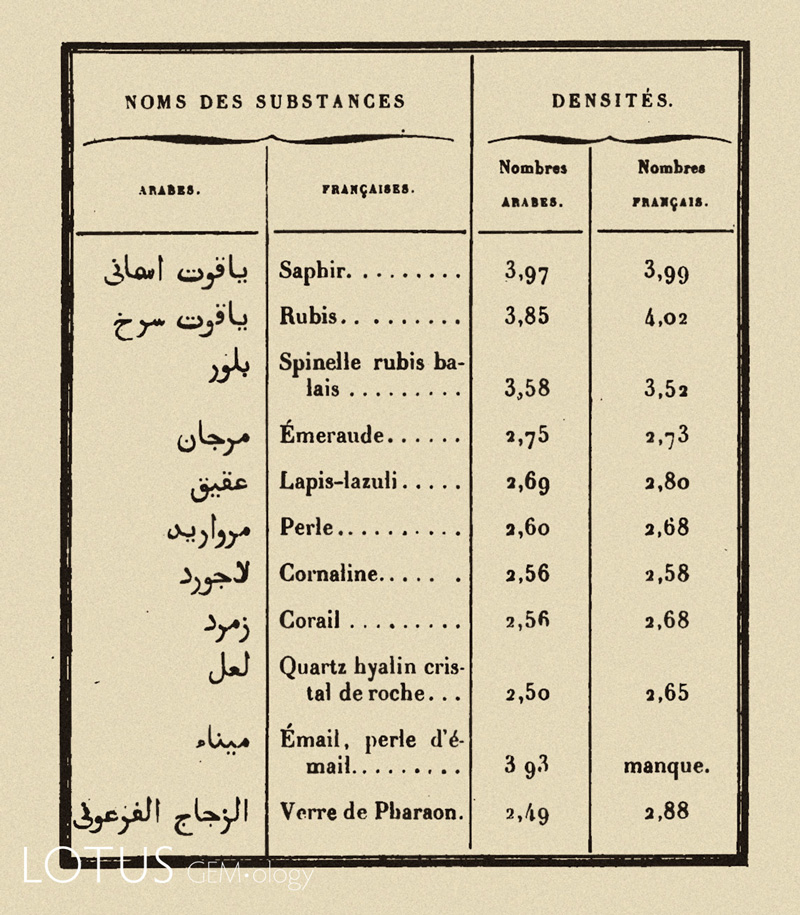 Figure 4. Table from Jacques Clément-Mullet’s 1866 “Essai sur la Minérologie Arabe,” which summarizes al-Bīrūnī’s specific gravity measurements. One can clearly see that he accurately separated corundum (saphir/rubis) from spinel (spinelle rubis balais) and many other gems. All the values obtained by al-Bīrūnī are remarkably close to the modern values. In essence, his measurements represent one of the earliest (perhaps the first?) instances of an arrangement of gems based on a mathematically measured property.
Figure 4. Table from Jacques Clément-Mullet’s 1866 “Essai sur la Minérologie Arabe,” which summarizes al-Bīrūnī’s specific gravity measurements. One can clearly see that he accurately separated corundum (saphir/rubis) from spinel (spinelle rubis balais) and many other gems. All the values obtained by al-Bīrūnī are remarkably close to the modern values. In essence, his measurements represent one of the earliest (perhaps the first?) instances of an arrangement of gems based on a mathematically measured property.
Following al-Bīrūnī, al-Khazinī of Merv, created his famous Balance of Wisdom (Figure 5) about 1121–1122 CE. This produced more precise measurements, allowing him to slightly correct al-Bīrūnī’s values. In addition, after proper calibration, it could calculate the specific gravity of virtually any element, including gold, silver, etc. Through a further series of clever calculations, one could also calculate the exact percentages of each element in an alloy (Yassi & Yassi, 2021).
'The Book Most Comprehensive in Knowledge on Precious Stones' (Kitāb al-Jamāhir)
When it comes to gemmology and mineralogy, the crown jewel of al-Bīrūnī’s oeuvre was his Kitāb al-Jamāhir fī maʿrifat al-jawāhir [The Book Most Comprehensive in Knowledge on Precious Stones]. Thankfully, this book has not just survived, but noted Pakistani historian, Hakim Mohammad Said, has produced an excellent English translation. This is a full 200+ page monograph on gems written over a thousand years ago, and Said adds copious notes and references. Yet this remarkable book is almost unknown in the gemmological world. The following discussion is largely based on Said’s translation (Said, 1989).
The Kitab al-Jamahir is a detailed description of the various stony materials considered precious at the time. Al-Bīrūnī methodically collected information from all accessible sources. The most important of these were two books on precious stones written by Abū Yūsuf Yaʿqūb ibn ʾIsḥāq al-Kindī (801–873 CE). Like al-Bīrūnī, al-Kindī was a polymath who wrote about philosophy, mathematics, astronomy, and optics and medicine/pharmacology, among other subjects. Known as the “Philosopher of the Arabs,” al-Kindī helped introduce the Islamic world to Greek philosophy, particularly that of Aristotle and Plato. Sadly al-Kindī’s books on gems have not survived, so we know of them only through mentions by other writers such as al-Bīrūnī.
Al-Bīrūnī also frequently quotes from his mentor, Abū Naṣr, although he states that Abū Naṣr generally followed the teachings of al-Kindī.
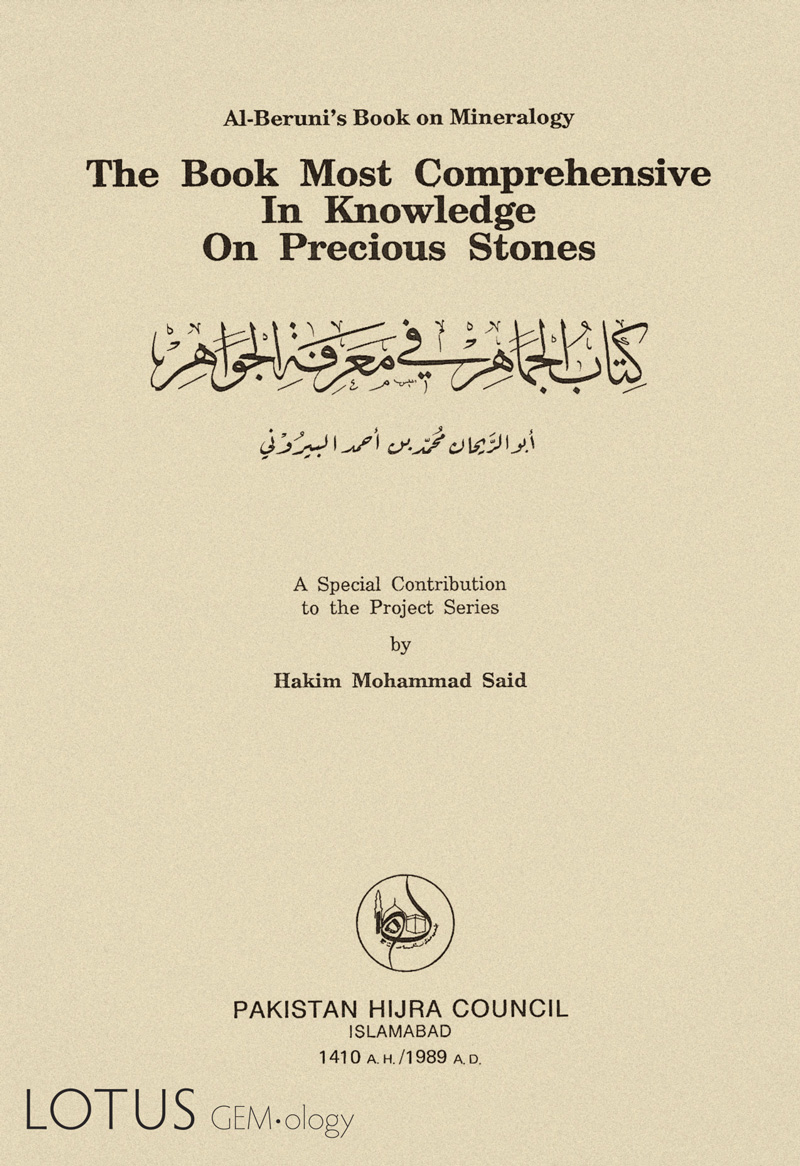 Figure 6. Title page of Hakim Mohammad Said's excellent 1989 translation of al-Biruni's Kitāb al-Jamāhir fī maʿrifat al-jawāhir, his landmark book on precious stones.
Figure 6. Title page of Hakim Mohammad Said's excellent 1989 translation of al-Biruni's Kitāb al-Jamāhir fī maʿrifat al-jawāhir, his landmark book on precious stones.
The book begins with a wide-ranging section that begins with praise to Allah, along with the various schemes rulers have used to hide their jewels. This section is peppered with philosophical thoughts, an emphasis on the hygienic importance of water (using a rather graphic example of how a cat cleans itself), a few parables, and even advice on sex and words of wisdom for newly married brides! He does separate in logical fashion plants from animals, and both from stony materials.
But the core of the book is the discussion of gems, in the following order: ruby (jacinth), diamond, emery, pearl, shell, emerald, turquoise, jaza (agate), beryl, rock crystal, coral, nephrite, and a smattering of other stones. The final part discusses minerals and metals.
Some Highlights
When one reads Kitab al-Jamahir, one encounters a razor-sharp mind that is always questioning, and certainly sometimes scathing in his discussion of anything or anyone whose ideas did not measure up to his keen intellect and logic. While he was supported by patrons, he was not above criticizing even them.
Here are a few highlights from the Kitab al-Jamahir, gently edited from the Said translation unless otherwise stated.
Al-Bīrūnī on Yashm (Hetian yù, or nephrite from Khotan):
Yashm, a precious stone mined from the Khutan region, is found in various valleys, including Fash, which produces the finest white yashm, and Qarafash, known for its blackish, opaque varieties. Large pieces of yashm were historically reserved for kings, while smaller ones went to the common people. The Turks valued yashm, calling it hajar al-ghalbdi, using it to adorn saddles, swords, and belts for protection in battle, as well as for making rings and clasps. The Kitab at-Nukhab states that the Turks believed yashm helped them conquer enemies and aided digestion, particularly after consuming heavy foods. Nasr described yashm as harder than turquoise, with a milky colour, transported by floods to the valley of Su in Turkistan, and cut using diamonds. Some believed it averted the evil eye and mitigated the effects of lightning, though sceptics noted that iron mirrors displayed similar properties without repelling lightning. Medical texts mention a related stone, yashb, used for stomach ailments and hung around the neck for relief. Galen experimented with yashb and confirmed its benefits for stomach pain, especially when a python-shaped pattern was inscribed upon it. Ibn Masah noted variations in its colour and texture, distinguishing it from similar stones like bash, a softer variety sometimes confused with yashm. Despite regional differences in nomenclature—yashb in Tirmiz, alshab in Bukhara—the stone remained widely regarded for its medicinal and protective properties.
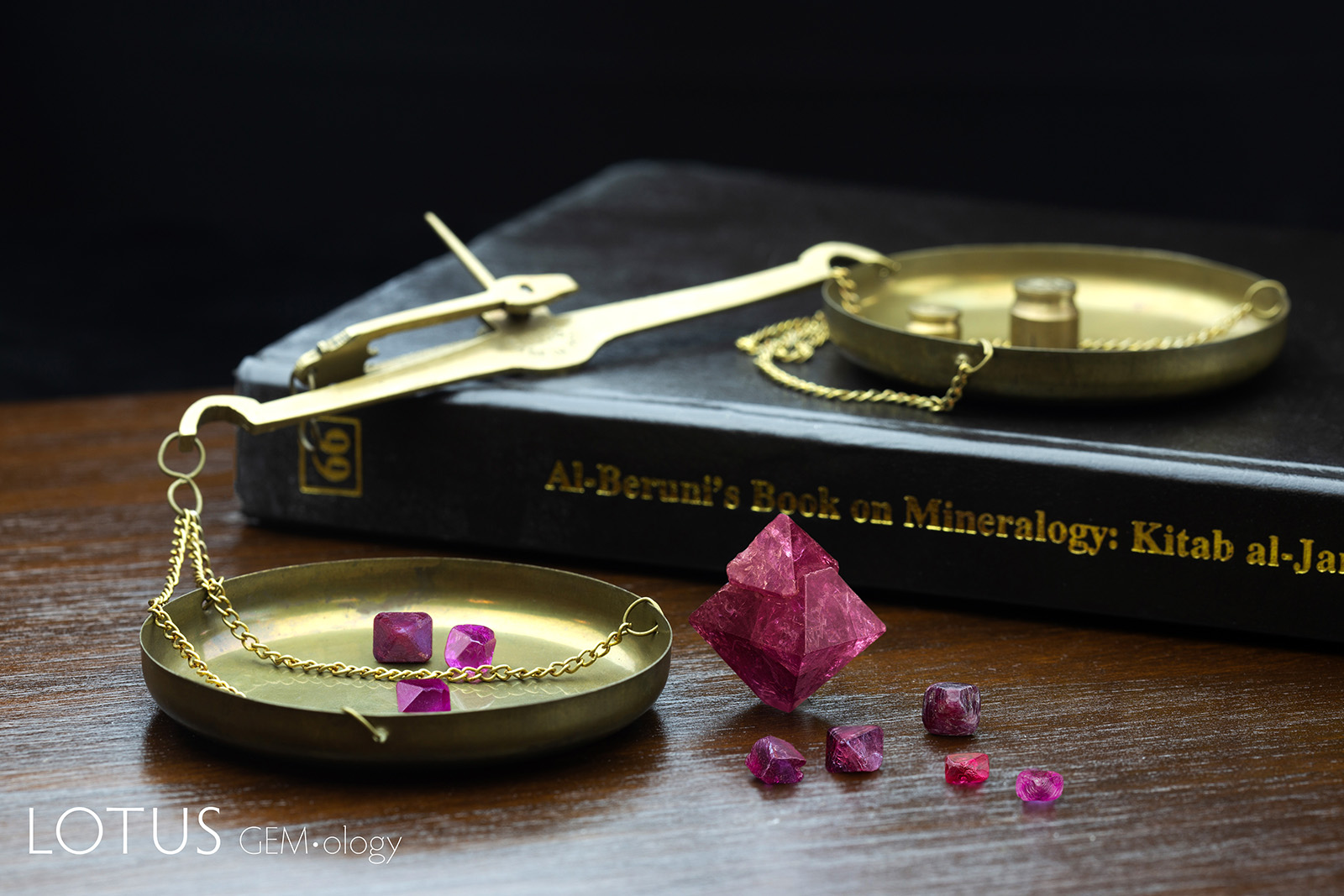 Figure 7. In some cases, ruby and red spinel can look beguilingly similar, as this collection of five rubies and four spinels from Burma demonstrates. Being of similar hardness and heft, this is why spinel and ruby were so often confused with one another. Indeed, it was not until 1798 that European mineralogists Count de Bournon and Charles Greville formally defined the mineral corundum. But al-Bīrūnī had separated ruby (yāqūt, ياقوت) from spinel (lāl, لال; balas ruby) some 800 years earlier, due to their slight differences in specific gravity. Photo: Ronnakorn Manorotkul/Lotus Gemology; specimens courtesy of Vincent Pardieu and Lotus Gemology. So, which are ruby and which are spinel? Find the answer at the end of the article.
Figure 7. In some cases, ruby and red spinel can look beguilingly similar, as this collection of five rubies and four spinels from Burma demonstrates. Being of similar hardness and heft, this is why spinel and ruby were so often confused with one another. Indeed, it was not until 1798 that European mineralogists Count de Bournon and Charles Greville formally defined the mineral corundum. But al-Bīrūnī had separated ruby (yāqūt, ياقوت) from spinel (lāl, لال; balas ruby) some 800 years earlier, due to their slight differences in specific gravity. Photo: Ronnakorn Manorotkul/Lotus Gemology; specimens courtesy of Vincent Pardieu and Lotus Gemology. So, which are ruby and which are spinel? Find the answer at the end of the article.
Benfeghoul (2022) states that eyeglasses were first believed to have been invented in Italy around 1285 CE, but points out that al-Bīrūnī describes a “ruby” magnifier nearly three hundred years earlier:
As-Sallāmī reported, on the authority of al-Laḥḥām, that Abū Bishr as-Sīrafī was at the house of his maternal uncle in Sarandīb. He then brought out a polished red ruby that he put on the letters of the book [or: the letter] in order to read it. The narrator expressed his surprise at this, considering that this would be in the darkness of the night, and that a transparent body would shine [by itself] without any light falling upon it from a shining object. This ruby was [formed] as a hemisphere, with its flat side lying on [lit. toward] the book. [In a similar way] small writings can [thus] be read with a similar object made of rock crystal [billaur], because the writing becomes larger for the sight, and the lines [i.e., the space between the lines] become wider. [To explain] the causes of this is a task for the discipline of optics.
Al-Bīrūnī on the value of Sabaj (jet or obsidian?):
Sabaj: It does not belong to the species of stones that are rated precious. Indeed, its beads are so worthless that they are hung from the necks of donkeys.
On the colour of ruby:
It has been said about the pomegranate-like colour of the ruby that, if scarlet blood is sprinkled and spread over a clean piece of silver, the resultant coloration would be like that of the pomegranate-coloured ruby. Scarlet blood is that which is temperate and healthy and besides, flows in the veins. The blood of the right ventricle is scarlet.
Here was an extremely careful man. It wasn’t enough to describe the colour as blood red; al-Bīrūnī even identified the heart ventricle it originated from.
While al-Bīrūnī was narrowly focused when discussing science, the author occasionally spiced up the discourse with flashes of wit. For example, here’s al-Bīrūnī discussing pearl dealer Ibn Jassas:
…[Ibn Jassas’] third quality was his foolishness. He was a most idiotic person. Abu Bakr Suli has heard from ‘Abd Allah bin Sulayman that the Caliph Mu'tadid-bi-Allah used to say:
“There are three wonders of the world. Two of them are non-existent and exist in name only. One of them is the 'unqah bird of the west and the other is kibrit-i-ahmar [red sulphur]. But there is a third wonder which is in existence and is stranger than both. This is Ibn Jassas, who despite being the most foolish of men, is an expert on pearls.”
His thoughts on jewellers are equally hilarious, something that every gemmologist can appreciate:
I shall also try to include everything that I have learnt from the jewellers, although the so-called famous stories of the jewellers are tinged with the fiction of the storytellers and the gossip of the bazaar. This falsehood is of such magnitude as to stun heaven and earth.
|
Al-Bīrūnī on the Heat Treatment of Ruby Heat treatment of corundum gems is generally viewed as first being recognized in the late 20th century. In 1966, the GIA’s Robert Crowningshield noted a chalky blue fluorescence of a Sri Lankan sapphire. This was the first indication of heat treating of Sri Lankan geuda sapphire, but it was not recognized as such until nearly a decade later. This process requires temperatures of >1350°C, as microscopic inclusions of TiO2 need to be dissolved into the crystal. However, the heat treatment of ruby had already been discovered no later than the mid 11th century. Written between 1040 and 1048 CE, al-Bīrūnī’s The Book Most Comprehensive in Knowledge of Precious Stones (Said, 1989) quotes al-Kindī, who describes the process as follows Al-Kindī writes: The purpose of the heat treatment is to remove the dark coloration and dark areas in ruby from Sri Lanka. Al-Kindī describes the heat treatment process in a furnace designed to melt 50 mithqals of gold (212 grams). Thus, we know that the temperature was in the range of 1100°C, as gold melts at 1064°C. He further indicates that the process was conducted for 1–24 hours. The process al-Bīrūnī describes was also described by al-Tifāshī 200 years later (Huda, 1998) and is often used today to improve the colour of rubies that have relatively low Fe and Ti content. The dark coloration is caused by the addition of a little blue coloration caused by the presence of a low concentration of the Fe2+–Ti4+ chromophore. Heating in the range of 900–1100°C in air or oxygen can oxidize some of the Fe2+ to Fe3+, reducing the amount of the Fe2+–Ti4+ chromophore. Conducting the process at this low a temperature prevents additional TiO2 in the ruby from dissolving into the crystal thus preventing further reduction of Fe3+ to Fe2+. Figure 8 shows the application of this process to a group of rubies from Möng Hsu, Burma. The process is very effective for rubies of this character. That this process could be easily conducted in the 9th century was simply because the temperature, as noted above, was much lower than that required to convert colourless or weakly coloured sapphire to a good blue colour. In fact, it is not clear how early the heat treatment of ruby was first discovered. Cassius-Duranton (2025) quotes Finot’s translation of the Sanskrit Ratnaparikscha mention by Kautilya’s Arthashastra (323–299 CE): The sapphire, if placed in the fire, can withstand a higher temperature than the ruby. But never, whether for testing or for enhancement, should any gem be put into fire. For if the fire, whose exact temperature is unknown, should alter it, that gem becomes harmful to whoever shapes, buys, or wears it. This prohibition against heating gems was not shared by all, as a variety of gems were known to being heated at that time, agate being just one. Pliny the Elder famously stated that when it came to counterfeiting gems: “Indeed, there is no other kind of fraud practiced, by which larger profits are made”. Al-Bīrūnī, describing this heat treatment process references and quotes al-Kindī’s description of it about two centuries earlier. Al-Kindī wrote two books about mineralogical matters, but neither has survived to the present day. However, al-Bīrūnī writing in the 11th century directly quotes al-Kindī’s 9th century book. Thus, it is not clear just how long ago ruby started to be heat treated to improve its colour. Like today, the knowledge was probably concealed from customers. What is particularly fascinating about this history is the fact that a major focus of two great polymaths of the era was gemmology. Both did extensive research on it, and both wrote major books on their work. Figure 8. Ninth-century technique for heating ruby |
Al-Bīrūnī Compared
So exactly how did al-Bīrūnī differ from other early gemmological writers, such as Aristotle, Theophrastus, Pliny the Elder, Damigeron and Marbode? From the Greek period through Pliny, scientific progress flourished in the polytheist, free-thinking environment. However, from the 4th century CE onward, the Christianization of the Roman Empire brought a new monotheist worldview that sometimes conflicted with classical natural philosophy. In an effort to “cleanse” thought, libraries were destroyed, and “Pagan” institutions of learning were closed. The European Classical world headed into what would become known as the Dark Ages (Moller, 2020).
In addition to encyclopaedic works like that of Pliny the Elder, “recipe” books were produced, such as the Stockholm Papyrus, a treatise on treating/counterfeiting gems (Caley, 1927). Others blend practical descriptions of how gems are counterfeited along with large amounts of mystical and supposed medicinal uses for gems. Damigeron’s De Virtutibus Lapidum (1st–2nd century BCE) gives the occasional nugget of fact along with a large helping of mystical lore (Damigeron & Tahill, 1989). Here’s a sample:
XXIX. The Stone Topaziolite.
If anyone has drunk wine of sea-eggs and become insane, give the madman the stone ground up in water in a small bowl to drink. Then put the stone round his neck and he will be cured.
XVIII. The Stone Lithos.
Lithite is a beautiful stone; useful against night-spirits, that is, vampires, or the canana: when worn around the neck it cures them.[2]
Damigeron, it should be noted, was the principal source for Marbode, whose Liber Lapidum [Book of Stones] was written around 1090–1100, almost contemporaneously with al-Bīrūnī.
To the East, in India, Sanskrit writings on precious stones were similar, a mixture of magic, medicine, and commercial information. While they do provide items of interest, even as late as the tenth century, works like the Garuda Purana were still filled with far more lore than logic. After the passing of Islam’s Golden Age, the world would have to wait for the European Enlightenment beginning in the late 17th century for serious progress in mineralogy and gemmology.[3]
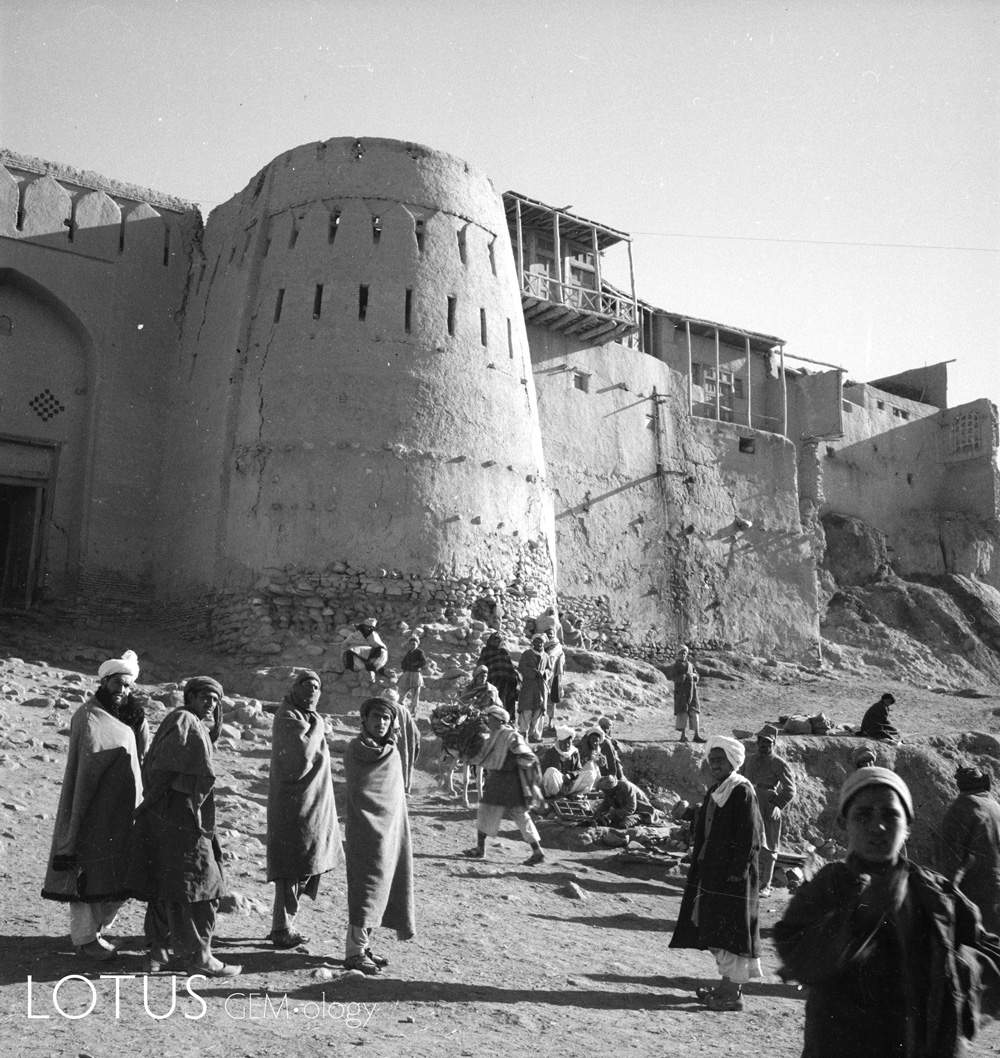 Figure 9. The ancient city walls of Ghazni, Afghanistan in 1939. Photo: Annamarie Schwarzenbach, Swiss National Library. Public domain.
Figure 9. The ancient city walls of Ghazni, Afghanistan in 1939. Photo: Annamarie Schwarzenbach, Swiss National Library. Public domain.
Revealed Vs. Discovered (Emperical) Knowledge
When all could see that human life lay degraded and helpless, crushed under the oppressive weight of superstition that loomed from the heavens with a terrifying scowl, it was a Greek who first dared to defy it. Unafraid of the gods’ reputations, thunderbolts, or the rumblings of the sky, he confronted superstition boldly, his courage only inflamed by its threats. With the strength of his mind, he pushed past the flaming walls of the cosmos, exploring the boundless universe through thought and reason. He returned from this intellectual expedition triumphant, bringing with him the knowledge of what can and cannot come to be, and the laws that govern all things, each bounded by its own natural limits. And so, the order of things was overturned – superstition was cast down and trampled, while humanity, through reason, was lifted up to the heavens in victory.
— Lucretius speaking of Epicurus[4]
On the Nature of Things, 1st Century BCE
Not unlike the early Christian period in Europe, a major debate in the Islamic scientific world existed during the time of al-Bīrūnī. This discussion dealt with an age-old question for many societies – revelation vs. discovery. Certain people believed that religious texts came directly from a divine entity (‘revelation’), and, as such they should not be questioned. In some cases, it could even be considered heresy to study anything outside the divine texts. At its extreme, in the minds of certain theocrats, there was literally nothing left to find beyond the holy books.
The other school of thought was that, while (sometimes) accepting the “revealed wisdom” of divine texts, knowledge comes primarily from sensory experience. In other words, our understanding of the world is based on what we perceive through our senses—seeing, hearing, touching, etc.—rather than through pure reason or intuition alone. This is the meaning of “empiricism.”
Empiricism emphasizes observation and experience as the foundation of knowledge. Thus, the natural world should be explored in all its forms to the best of our abilities, and that process of investigation will lead to demonstrable truths that can be repeated by others and withstand the arguments of critics (Starr, 2014, 2023).
It was a debate for the ages. To understand al-Bīrūnī’s position on such matters, we can look to a story he told in his Kitab al-Hind (edited from Sparavigna, 2013):
Parable of the Four Pupils
A teacher was travelling together with four of his pupils deep in the night. On the road ahead appeared something standing erect, but the darkness prevented a better view. The teacher turned to his pupils and asked them what it was.
The first simply said: “I do not know.”
The second: “I do not know nor have the means of learning what it is.”
The third said: “It is useless to examine it now, for the coming daylight will reveal it.”
It was clear that none of them understood how to arrive at a logical conclusion: the first because of his ignorance, the second was incapable of learning, and the third because he was lazy.
The fourth pupil did not give an answer. After the others answered, he walked towards the object. On coming near, he found it was stacked pumpkins on which there was something entangled. He considered that no living man could stand so still, and therefore it was a lifeless object. To be certain, he kicked it over. Thus, having removed all doubt, he returned to his master and gave his account.
— A.C. Sparavigna (2013) The science of al-Bīrūnī
For al-Bīrūnī, unlike virtually all gemmologists who came before him, reasoning and speculation were not enough. He was a major proponent of experimental science. Neither hearsay nor philosophy was worth as much as direct experience. Al-Bīrūnī firmly believed that mathematical measurement was the key to establishing truth, that mathematical concepts could accurately model reality. In that sense, al-Bīrūnī was one of the earliest exemplars of what we now call the scientific method, hundreds of years ahead of John Locke (1632–1704) and the other founders of the modern empiricism movement (Starr, 2014, 2023).
Sadly, that questioning inquisitive nature brought him and other Arabic-language empiricists into conflict with those for whom even asking questions could be considered heresy. This, coupled with an invasion by Genghis Khan, which destroyed much of the region’s infrastructure – along with the Timurid campaigns (1383–1385) and outbreaks of plague – brought the Golden Age of Islamic science to a halt, sending Central Asia into an intellectual and economic collapse from which it has yet to recover. Today, the region is one of the world’s poorest and least developed.
|
Inconvenient Questions Humans have a long history of punishing those who ask “inconvenient” questions. Two thousand five hundred years ago in Greece, Anaxagoras was arrested and exiled for the crime of suggesting that the Sun and Moon were not gods, but rocks (a crater on the moon is now named in his honour; Warmflash, 2019). In Italy, Giordano Bruno was executed in 1600 for theological heresies (rejection of Catholic doctrines, belief in an infinite universe, stars being distant suns with their own planets, life on other planets, reincarnation of the soul, among other things). Galileo Galilei was placed under house arrest until death in 1642 for heliocentrism (belief that the earth orbits the sun). The library, however, may have escaped destruction and still been in existence when Alexandria capitulated to the Arabs in 642, if we can believe a picturesque tale preserved in Arab sources. This relates that a Greek savant, who was a friend of the commander of the army that took over the city, asked him for the library as a gift. The commander prudently referred the matter to his overlord… and was told: ‘If these writings of the Greeks agree with the book of God, they are useless and need not be preserved; if they disagree, they are pernicious and ought to be destroyed.’ And destroyed they were, by being handed over to the city’s baths for fuel, and, the story specifies, they sufficed to feed the furnaces of all four thousand of them for six months. |
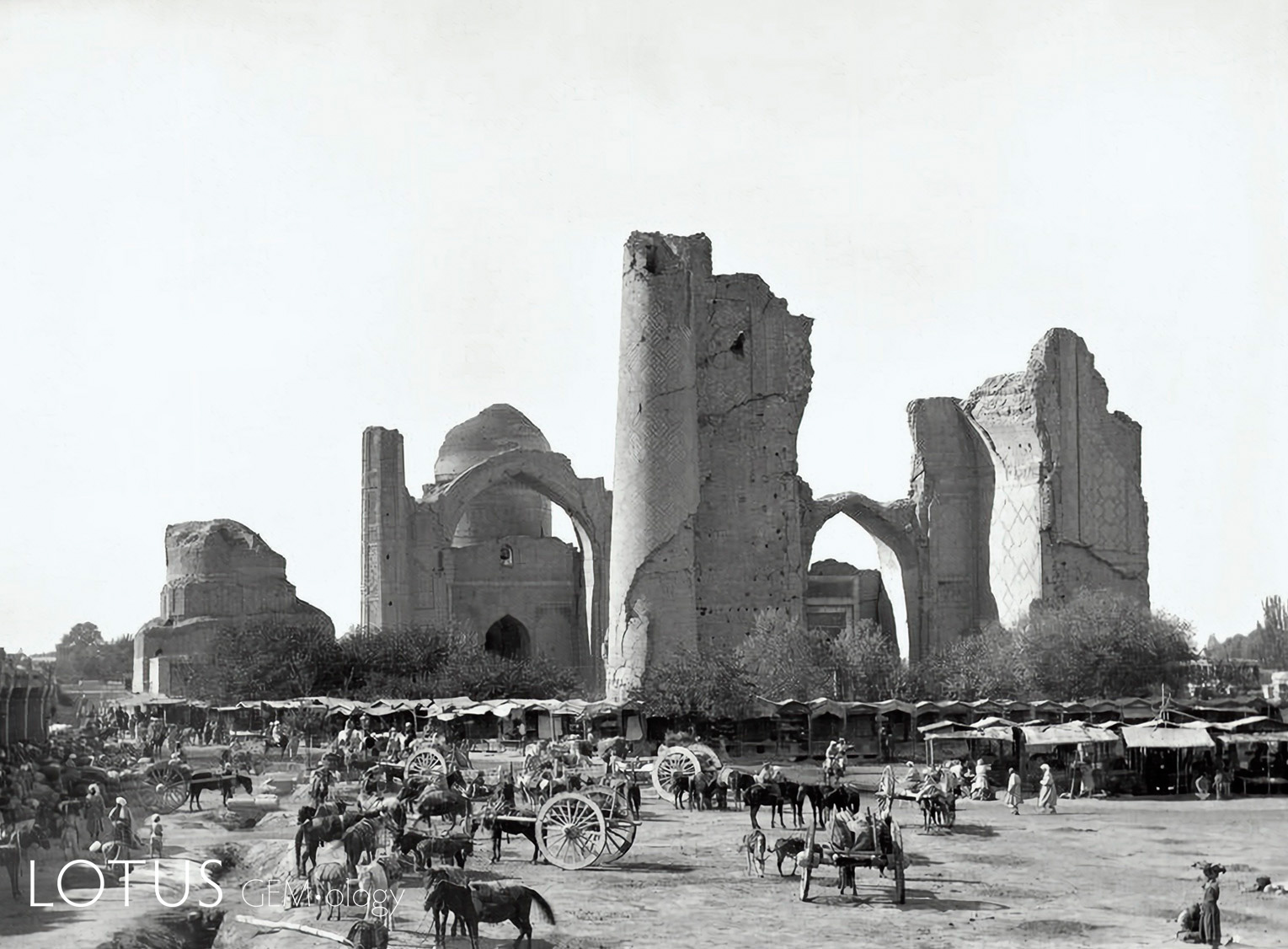 Figure 10. Ruins of the Bibi Khanum Mosque surrounded by a bazaar in Samarkand in what is now Uzbekistan, c. 1890. Public domain.
Figure 10. Ruins of the Bibi Khanum Mosque surrounded by a bazaar in Samarkand in what is now Uzbekistan, c. 1890. Public domain.
Al-Bīrūnī died in Ghazni (Afghanistan) in 1048 at age 77. His tomb, badly damaged in an earthquake in 1974, was rebuilt. In May 2019, the Taliban tried to destroy it, but it is again said to be undergoing refurbishment (Starr, 2023).
Today, across the Islamic world, there are universities and schools named in al-Bīrūnī’s honour. One of them, Alberoni University, is in Afghanistan. It was opened in 1998… under the Taliban, illustrating that unique fact of history commonly attributed to the American humourist, Mark Twain: “History doesn’t repeat itself… but it often rhymes.”
••••
Postscript
There is one more discovery that we forgot to mention: The “New World.” Al-Bīrūnī discovered that, too, without ever setting foot there or having even seen a true ocean. Combining mathematics, astronomy and geography, he was able to calculate with surprising precision both the circumference of the earth and then plot a map of the known world on a model sphere he constructed for that purpose.
As previously discussed, al-Bīrūnī was not the first to measure the earth’s circumference, nor was his method the most accurate (current estimates suggest he was within two percent of the modern value). But he did something with his measurement that no one else seems to have accomplished. Using the latitude and longitude data he had collected over the course of his lifetime, al-Bīrūnī noticed Eurasia occupied only two fifths of the globe. A huge empty area lay on the other side. Frederick Starr described it thus:
After Mahmud’s death in 1030, al-Bīrūnī hauled his field notes and papers back to Ghazni in Afghanistan, where Mahmud’s son, Masud I (ruled 1031–1040), welcomed him and supported his research and writing. Al-Bīrūnī compiled his lifetime’s research on specific gravity before turning to his most ambitious work, the Codex Masudicus, a comprehensive tome summarizing all known knowledge on astronomy and allied disciplines. In this work, he explored the possibility of a heliocentric universe, suggesting that the idea of the Earth revolving around the Sun was as logical as the prevailing geocentric model and urging mathematicians and astronomers to either prove or disprove it. Due to its groundbreaking content, historians of science regard the Codex Masudicus as the most significant astronomical work between late antiquity and the modern era.
Al-Bīrūnī also speculated on the existence of North and South America. His research on the Earth’s circumference, conducted at Nandana, formed the basis for his new, more accurate map of the world. By expanding his list of longitudes and latitudes to include more than 70 sites in India and hundreds of locations across Eurasia, al-Bīrūnī realized that the known landmass—from Africa’s westernmost point to China’s eastern coast—covered only two-fifths of the globe, leaving the remaining three-fifths of Earth’s surface unaccounted for.
The most obvious way to explain the 15,000-mile gap in the Earth’s known landmass was the long-accepted idea that Eurasia was surrounded by a “World Ocean.” However, al-Bīrūnī questioned whether three-fifths of the Earth’s circumference could truly be nothing but water. Drawing on his studies of specific gravity, he noted that most solid minerals were heavier than water and reasoned that an overwhelmingly watery world would cause planetary imbalances over time. Furthermore, he argued that the same forces that shaped two-fifths of the Earth’s surface should have also affected the remaining three-fifths. This led him to hypothesize the existence of one or more unknown continents somewhere between Europe and Asia. To determine whether these landmasses were inhabited or empty, al-Bīrūnī examined longitude data, observing that human populations existed in a broad north-south band from Russia to India and Africa. If the unknown continents were uninhabited, they would have to be located north or south of this band. Applying Aristotelian logic, he reasoned that the forces shaping Eurasia would have acted elsewhere as well. Since there was no evidence suggesting all unknown land was confined to the extreme latitudes, he concluded that these continents must be habitable—as they indeed turned out to be. By 1037, after decades of research, al-Bīrūnī had already theorized the existence of the New World, centuries before its official European discovery.
— S. Frederick Starr (2013) So, who did discover America?
History Today, Vol. 63, No. 12
Columbus proved him right… 455 years later.
Al-Bīrūnī, the first anthropologist, the founder of Indology, the father of geodesy, the discoverer of the New World. While others (plural) may have independently discovered some of the same concepts before he lived, al-Bīrūnī accomplished all this himself.
Was he the GGOAT — The Greatest Gemmologist of all Time? We are sure he would laugh at the thought. After all, his own words explain exactly what he had accomplished…
And I have truly done what everyone is bound to do in respect of any particular science, that is, to accept gratefully the original contributions of his predecessors, to correct fearlessly the errors that come to his notice and to preserve what he himself discovers and to leave it as a record for the future generations that are to follow him in time.

|
Spinel vs. Ruby Puzzle from Figure 7
|

About the Authors
Richard W. Hughes is one of the world’s foremost experts on ruby and sapphire. The author of many books and over 170 articles, his writings and photographs have appeared in a diverse range of publications, and he has received numerous industry awards. Co-winner of the 2004 Edward J. Gübelin Most Valuable Article Award from Gems & Gemology magazine, the following year he was awarded a Richard T. Liddicoat Journalism Award from the American Gem Society. In 2010, he received the Antonio C. Bonanno Award for Excellence in Gemology from the Accredited Gemologists Association. The Association Française de Gemmologie (AFG) in 2013 named Richard as one of the Fifty most important figures that have shaped the history of gems since antiquity. In 2016, Richard was awarded a visiting professorship at Shanghai's Tongji University. 2017 saw the publication of Richard and his wife and daughter's Ruby & Sapphire • A Gemologist's Guide, arguably the most complete book ever published on a single gem species and the culmination of four decades of work in gemology. In 2018, Richard was named Photographer of the Year by the Gem-A, recognizing his photo of a jade-trading market in China, while in 2020, he was elected to the board of directors of the Accredited Gemologists Association and was appointed to the editorial review board of Gems & Gemology and The Australian Gemmologist magazine. In 2022, Richard published Jade • A Gemologist's Guide, while 2024 brought Broken Bangle • The Blunder-Besmirched History of Jade Nomenclature. His jade trilogy was completed in 2025 with his translation of Heinrich Fischer's Nephrite and Jadeite.
Lisbet Thoresen is an independent researcher specialized in the gem minerals used in the production of glyptic in the ancient world, with a focus on four subject areas: gemstone identity and geographic origin determination, transmission and trade, ancient treatment techniques, and interpreting ancient literature on gems. This research integrates gemmology and archaeometry, or archaeogemmology, into ancient gem studies traditionally based on connoisseurship and archaeology. Previously, she was associate conservator of Greek and Roman antiquities at the J. Paul Getty Museum, Malibu, California.
Dr. John Emmett is one of the world's foremost authorities on the heat treatment, physics, and chemistry of corundum. He is a former associate director of Lawrence Livermore National Laboratory and a co-founder of Crystal Chemistry, which is involved with heat treatment of gemstones.
Acknowledgements
Richard Hughes thanks his former colleague, William Sersen, for introducing him to al-Bīrūnī.
Footnotes
[1] Patronage dates to Antiquity. One among many examples was the Greek ruler Ptolemy II Philadelphos (r. 283–246 BCE), whose father created the Mouseion (from which our word ‘museum’ is derived). This included a great library in Alexandria. Its purpose was to draw artists, writers, thinkers from around the ancient world to his court and make Alexandria the preeminent cultural and intellectual center of the ancient world (Casson, 2001).
[2] Powerful stuff. Who needs “A Diamond is Forever” when you can market your gems like: “Lithite… or the Vampire: The Choice is Yours.”
[3] A nice summary of the history of geology and mineralogy from early times to the 20th century from a European perspective is provided by Adams (1938).
[4] The Epicurean movement, founded by Epicurus in the 4th century BCE, was a school of philosophy that sought to achieve a life free of pain and fear through the pursuit of rational pleasure, moderation, and knowledge of nature. At its core, Epicureanism taught that the gods, if they exist, are indifferent to human affairs and that the soul is material and perishes with the body—thereby eliminating the fear of divine punishment and death. Epicureanism was a deeply ethical and materialist philosophy, promoting a worldview grounded in atomism, empirical reasoning, and the rejection of superstition. Its influence persisted quietly through the centuries and played a key role in the intellectual shifts of the European Renaissance and Enlightenment (Warren, 2009).

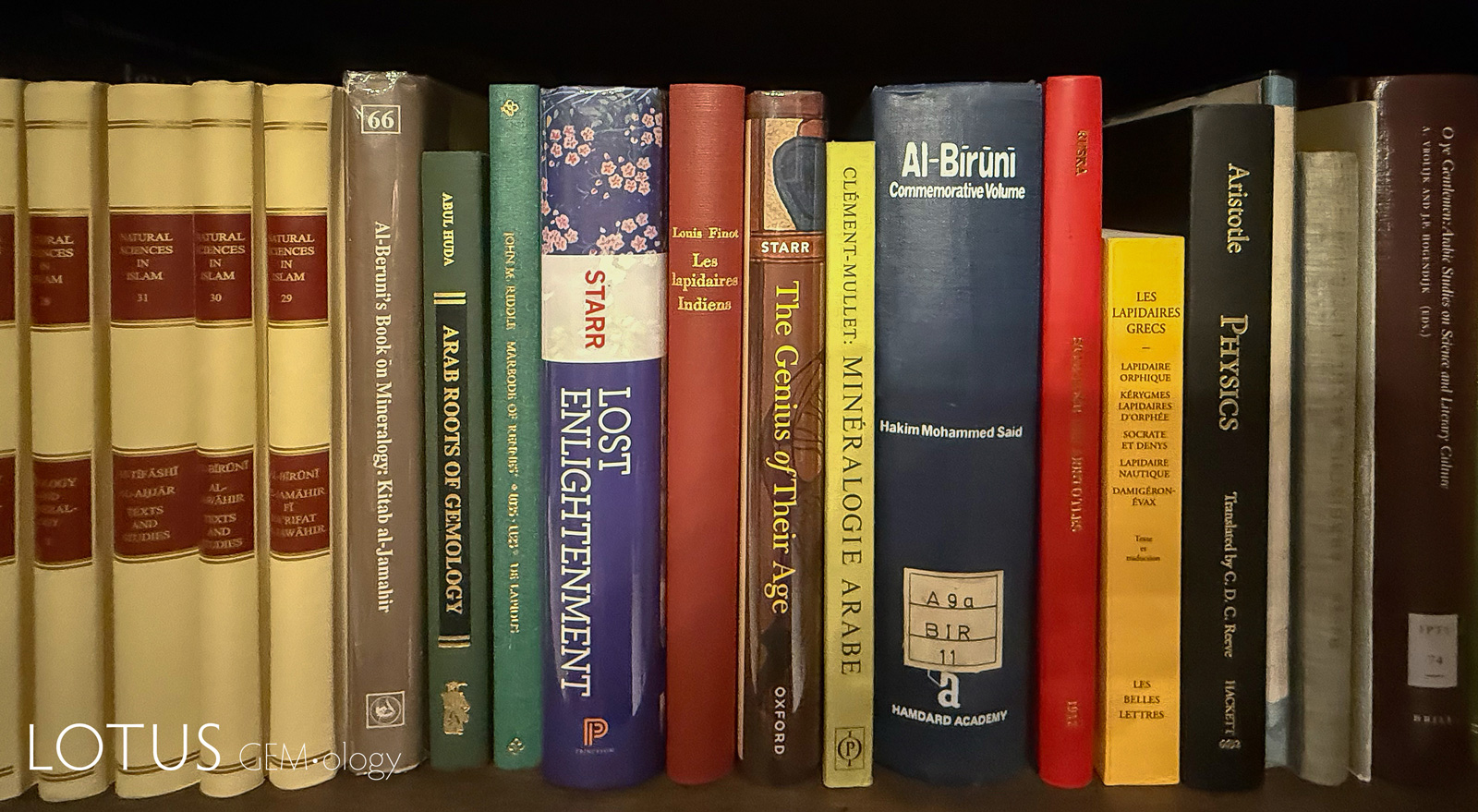 Figure 11. Some of the books on al-Bīrūnī and other Arabic, Indian and Greek lapidaries in Richard Hughes' personal library. Photo: Richard W. Hughes/Lotus Gemology
Figure 11. Some of the books on al-Bīrūnī and other Arabic, Indian and Greek lapidaries in Richard Hughes' personal library. Photo: Richard W. Hughes/Lotus Gemology
Notes
First published in the Journal of Gems & Gemmology in 2025.
References & Further Reading
In the post-WWII era, British biologist Joseph Needham (1900–1995) authored the incredible Science and Civilization in Chinaseries of books (Needham, 1954–present), detailing the technological achievements of China over the millennia. This work was among the first to introduce the West to Chinese scientific accomplishments and was critical in debunking the then-Eurocentric ideas that most major discoveries originated in the West.
Certainly, one of the major reasons that Arabic (and Chinese) works have largely been ignored in the West is simple ignorance due to the dearth of translations into Roman-alphabet languages (Ansari, 1975). For this reason, we have compiled an extensive bibliography of Arabic-language mineralogy/gemmology references. This bibliography is also available online at Lotus Gemology’s Four Treasures Reference Database, a searchable online database with nearly 9,000 references on gems and gemmology.
For those who would like to explore this subject further, we can highly recommend the two books written by Frederick Starr (2014, 2023), which are exceptional introductions to the works of al-Bīrūnī and the Golden Age of Islamic science.
References
- Ahmed, A.S. (1984) Al-Beruni: The first anthropologist. RAIN, No. 60, pp. 9–10.
- Al-Bīrūnī, M.i.A. (1025 CE), Maqālah fī al-nisab allatī bayn al-filizzāt wa al-jawāhir fī al-ḥajm مقالة في النسب التي بين الفلزات والجواهر فيالحجم. [Treatise on the Ratios Between the Volumes of Metals and Jewels]. [in Arabic]. Edited by Editor, Translated by Translator, Beirut: St. Joseph University, Edition.
- Al-Bīrūnī, M.i.A. (n.d., ca 1040–1048) Kitab al-jamahir fi ma’rifat al-jawahir (كتاب الجماهير في معرفة الجواهر). [The People’s Book on the Knowledge of Gems]. [in Arabic], Cairo: In Arabic, see pp. 38, 41, 81–82.
- Al-Bīrūnī, M.i.A. and Barani, S.H. (1954) Al-Qanunu’l-Mas’udi (القانون المسعودي) (Canon Masudicus) Vol. 1. [An Encyclopedia of Astronomical Sciences]. [in English with Arabic text], Hyderabad: Osmania Oriental Publications Bureau, 125 pp. + Arabic text.
- Al-Khalili, J. (2009) Science and Islam. United Kingdom: BBC video, 3 episodes, 3 hours.
- Al-Khalili, J. (2010) Pathfinders: The Golden Age of Arabic Science. London: Allen Lane, 336 pp.
- Ansari, S.M.R. (1975) On the physical researches of al-Bīrūnī. Indian Journal of History of Science, Vol. 10, No. 2, pp. 198–217.
- Batchelor, D.A.-F. (2015) Al-Bīrūnī: Outstanding ‘Modern’ Scientist of the Golden Age of Islamic Civilisation. International Institute of Advanced Islamic Studies, 13 pp.
- Benfeghoul, F. (2022) Through the lens of Islam: The pre-history of eye-glasses according to Arabic sources. Zeitschrift für Geschichte der Arabisch-Islamischen Wissenschaften, Vol. 23, pp. 259–315.
- Boetius de Boodt, A. (1609) Gemmarum et Lapidum Historia. [History of Gems and Stones]. [in Latin], Hanover: 1st ed., 294 pp.
- Bournon, C., de (1798) An analytical description of the crystalline forms of corundum, from the East Indies, and from China. Philosophical Transactions of the Royal Society of London, Vol. 88, pp. 428–448.
- Caley, E.R. (1927) The Stockholm Papyrus. Journal of Chemical Education, Vol. 4, No. 8, August, pp. 979–1002.
- Caley, E.R. and Richards, J.C. (1956) Theophrastus on Stones. Columbus, OH: Ohio State University, 238 pp.
- Cassius-Duranton, M.-L. (2025) Le traitement thermique des gemmes: Histoire d’un savoir-faire ancestral, de l’expérience à la science. [The heat treatment of gemstones: The history of an ancestral skill, from experience to science]. [in French], Revue de Gemmologie A.F.G., No. 225, March, pp. 16–20.
- Casson, L. (1989) The Periplus Maris Erythraei. Princeton, NJ: Princeton University Press, 320 pp. (see p. 230).
- Casson, L. (2001) Libraries in the Ancient World. New Haven, CT: Yale University Press, 192 pp.
- Clément-Mullet, J.J. (1868) Essai sur la minéralogie Arabe. [Essay on Arabic Mineralogy]. [in French], Journal Asiatique, Sixth Series, Vol. 5, January, pp. 1–81; February–March, pp. 109–253; June, pp. 502–522.
- Crone, P. and Hinds, M. (1986) God’s Caliph | Religious Authority in the First Centuries of Islam. Cambridge: Cambridge University Press, 156 pp.
- Crowningshield, R. (1966) Developments and Highlights at the Gem Trade Lab in New York: Unusual items encountered [sapphire with unusual fluorescence]. Gems & Gemology, Vol. 12, No. 3, Fall, p. 73.
- Damigeron and Tahill, P.P. (1989) De Virtutibus Lapidum or the Virtues of Stones. [in English and Latin], Translated by Tahill, P.P., Seattle, WA: Ars Obscura, reissue of 2nd century B.C. lapidary, vii, 75 pp.
- Eichholz, D.E. (1965) Theophrastus | De Lapidus. Oxford: Clarendon Press, 141 pp.
- Greville, C. (1798) On the corundum stone from Asia. Philosophical Transactions of the Royal Society of London, Vol. 88, pp. 403–448.
- Hamarneh, S.K. (1988) Introduction to al-Bīrūnī’s Book on Precious Stones and Minerals (al-Jamahir fi ma’rifat al-jawahir), with Interpretation and Evaluation. Karachi, Pakistan: Hamdard Foundation Press, 1st ed., 34 pp.
- Ibn al-Akfānī, M.i.M.i.a.-ʿ. (1908) Nukhbat al-dhakha’ir fī aḥwāl al-jawāhir [كتاب نخب الذخائر في أحوال الجواهر]. [The Choicest Treasures on the Properties of Gems]. [in Arabic], Al-Machriq, Translated by P.L. Cheikho, Vol. 11, 1005 pp. [see pp. 751–765].
- Khanikoff, N. (1860) Analysis and extracts of كتاب ميزان الحكمة Book of the Balance of Wisdom, an Arabic work on the water-balance written by al-Khâzinî in the Twelfth Century. Journal of the American Oriental Society, Vol. 6, pp. 1–128.
- Lucretius, Rouse, W.H.D. and Smith, M.F. (1992) Lucretius: On the Nature of Things. Loeb Classical Library, Cambridge, MA: Harvard University Press, 672 pp.
- Lynch, P. (2021) Al Bīrūnī and the Size of the Earth. ThatsMaths.com, <https://thatsmaths.com/2021/06/10/al-biruni-and-the-size-of-the-earth/>, accessed 21 April 2025.
- Masood, E. (2008) Science & Islam | A History. London: Icon Books, 240 pp.
- Needham, J. (1954–present) Science and Civilization in China. Cambridge: Cambridge University Press, multiple volumes.
- Posidippos of Pella (2002) Posidippi Pellaei Quae Supersunt Omnia. [All that survives of Posidippus of Pella]. [in Latin and Italian], by Austin, C. and Bastianini, G., Biblioteca Classica, No. 3, Milan: LED Edizioni Universitarie, 234 pp.
- Roller, D.W. (2010) Eratosthenes’ Geography. Princeton: Princeton University Press, 320 pp.
- Said, H.M. (1989) The Book Most Comprehensive in Knowledge on Precious Stones: al-Beruni’s Book on Mineralogy [Kitab al-jamahir fi marifat al-jawahir]. Translated by Said, H.M., One Hundred Great Books of Islamic Civilization, Natural Sciences No. 66, Islamabad: Pakistan Hijra Council, 355 pp.
- Saint-Denis, E., de (1972) Pline l’Ancien | Histoire Naturelle. Livre XXXVII. [Pliny the Elder | Natural History. Book 37]. [in French and Latin], Paris: Les Belles Lettres, 292 pp.
- Sersen, W.J. (1991) Gemstones and early Arabic writers. Gemological Digest, Vol. 3, No. 2, pp. 34–40.
- Sparavigna, A.C. (2013) The science of al-Bīrūnī. International Journal of Sciences, Vol. 2, No. 12, pp. 1–11.
- Starr, S.F. (2013) So, who did discover America? History Today, Vol. 63, No. 12, December, pp. 40–45.
- Starr, S.F. (2014) Lost Enlightenment: Central Asia's Golden Age from the Arab Conquest to Tamerlane. Princeton, NJ: Princeton University Press, 680 pp.
- Starr, S.F. (2023) The Genius of Their Age | Ibn Sina, Bīrūnī, and the Lost Enlightenment. New York: Oxford University Press, 301 pp.
- Thoresen, L. (2017) Archaeogemmology and ancient literary sources on gems and their origins. In Gemstones in the First Millennium AD: Mines, Trade, Workshops and Symbolism, Edited by Greiff, S., Hilgner, A. and Quast, D., Mainz: Römisch-Germanischen Zentralmuseum (RGZM), RGZM Tagungen 30, pp. 155–217.
- Walton, S.A. (2001) Theophrastus on Lyngurium: Medieval and early modern lore from the classical lapidary tradition. Annals of Science, Vol. 58, pp. 357–379.
- Warmflash, D. (2019) An ancient Greek philosopher was exiled for claiming the moon was a rock, not a god. Smithsonianmag.com, 20 June; <https://www.smithsonianmag.com/science-nature/ancient-greek-philosopher-was-exiled-claiming-moon-was-rock-not-god-180972447/>, accessed 8 April 2025.
- Warren, J., editor (2009) The Cambridge Companion to Epicureanism. Cambridge Companions to Philosophy, Cambridge: Cambridge University Press, 309 pp.
Further Reading
- Adams, F.D. (1938) The Birth and Development of the Geological Sciences. Baltimore: Williams & Wilkins, 506 pp.
- Adamson, P. (2022) Don't Think for Yourself | Authority and Belief in Medieval Philosophy. Notre Dame, IN: University of Notre Dame Press, 176 pp.
- Ahmad, R. (2010) Al-Bīrūnī: A Great Muslim Scientist, Philosopher and Historian (973–1050 AD). Journal of Pakistan Vision, Vol. 10, No. 1, pp. 167–179.
- Ahmad, S.M. Geodesy, geology and mineralogy | geography and cartography. In History of Civilizations of Central Asia, Vol. 4, The Age of Achievement: A.D. 750 to the end of the fifteenth century; Part 2: The achievements.
- Al-Bayhaqī, a.-ʿ.i.a.-Ḥ. (1985) Mādīn al-Nawādir fī Maʿrifat al-Jawāhir (مادِنُ النَّوَادِرِ فِي مَعْرِفَةِ الْجَوَاهِرِ). [The Mine of Rare Gems in the Knowledge of Jewels]. [in Arabic], al-Safat, al-Kuwayt: Maktabat Dar al-Urubah, al-Tabah 1 (facsim. of 15th century ed.), 158 pp.
- Al-Hassan, A.Y., Ahmed, M. and Iskandar, A.Z., editor (2001) The Different Aspects of Islamic Culture | Vol. 4: Science and Technology in islam. Part1: The Exact and Natural Sciences; Part 2: Technology and Applied Sciences. Paris: UNESCO Publishing, 527, 726 pp.
- Al-Hilālī, T.e.-D. (1941) Die Einleitung zu al-Bīrūnīs Steinbuch: mit Erläuterungen übersetzt. [Introduction To Al-Biruni's Stone Book]. [in German], Translated by al-Hilālī, T.a.-D., Leipzig: Otto Harrassowitz, 41 pp.
- al-Tīfāshī, A.i.Y.i.I. (2001) Aḥmad Ibn Yūsuf al-Tīfāshī K. Azhār al-afkār fī jawāhir al-aḥjār. Texts and Studies. Collected and Reprinted. [Ahmad Ibn Yusuf at-Tīfāshī, K. Azhār al-afkār fī jawāhir al-aḥjār: Texts and Studies]. [in Arabic, Italian & French], Natural Sciences in Islam, Frankfurt am Main: Institut für Geschichte der arabisch-islamischen Wissenschaften an der Johann Goethe-Universität, Vol. 31, reprinted 2022, 427 pp.
- al-Tīfāshī, A.i.Y.i.I. and Rainer, A. (1818) Fior di pensieri sulle pietre preziose di Ahmed Teifascite / Opera stampata nel suo originale arabo, colla traduzione italiana appresso, e diverse note di Antonio Raineri. [Flower of Thoughts on Precious Stones by Ahmed Teifascite / A work printed in its original Arabic, with an Italian translation and various notes by Antonio Raineri]. [in Italian and Arabic], Firenze: Tipografia orientale Mediceo-Laurenziana, 118 pp.
- Anawati, G.C. (1979) The Kitab al-Jamahir Fi Ma’rifa al-Jawahir of al-Bīrūnī. In Al-Bīrūnī Commemorative Volume, Edited by Said, H.M., Karachi: Hamdard National Foundation, pp. 437–453.
- Aristotle and Lee, H.D.P., editor (1952) Meteorologica. [in English and Greek], Cambridge, MA: Harvard University Press, 397 pp.
- Azad, A. (2016) Islam's forgotten scholars. History Today, October, pp. 24–31.
- Belenitzki, A.M. (1950) Al-Bīrūnī’s knowledge of mineralogy. [Bīrūnī | Collection of Articles]. In Bīrūnī | Sbornik statej, [in Russian] Edited by Tolstov, S.P., Moscow-Leningrad: Akademija Nauk SSSR, Academy of Sciences (Akademia Nauk) 2. BS Biriini Sbornik (Moscow-Leningrad, 1950) 3. IAI Istoriko-astronomicheskie Issledovaniya., pp. 88–105.
- Bromehead, C.E.N. (1945) Geology in Embryo (up to 1600 A.D.). Proceedings of the Geologists’ Association, Vol. 56, Pt. 2, pp. 89–134.
- Chelkouski, P.J., editor (1975) The Scholar and the Saint: Studies in Commemoration of Abuʼl-Rayhan al-Bīrūni and Jalal al-Din al-Rūmī. New York: New York University Press, 306 pp.
- Clément-Mullet, J.J. (1837) Pour servir à l'histoire de la lithotritie, principalement chez les Arabes. [To contribute to the history of lithotripsy, mainly among the Arabs]. [in French], Journal Asiatique, June, pp. 525–533.
- Content, D.J., editor (1987) Islamic Rings & Gems. London: Philip Wilson Publishers Ltd., 551 pp.
- Courtois, S.J. and Ishaque, M., editor (1951) Al-Bi̅ru̅ni̅ Commemoration Volume | A.H. 362–A.H. 1362. Iran Society: Calcutta, 303 pp.
- Dimishqi, A.a.-F.J.f.i.A. (2011) The Indicator to the Virtues of Commerce [Al-ishara ila mahasin al-tijara]. [in Arabic], Translated by Setia, A., Kuala Lumpur: Islamic Banking and Finance Institute Malaysia, 172 pp.
- Dodge, B., editor (1970) The Fihrist of al-Nadim | A Tenth-Century Survey of Muslim Culture. New York: Columbia University Press, 2 Vols., 1149 pp.
- Fielding, N., editor (2020) Selected Works of Chokan Valikhanov. London: Embassy of the Republic of Kazakhstan in the United Kingdom, 320 pp.
- Frähn, C.M. (1842) Über den Jakut. [About the jakut]. [in German], Schriften der Russisch-Kaiserlichen Gesellshaft für die Gesammte Mineralogie [Writings of the Russian Imperial Society for General Mineralogy], Vol. 2, No. 1, pp. 364–371.
- Frankopan, P. (2015) The Silk Roads: A New History of the World. Knopf, 636 pp.
- Freely, J. (2011) Light From the East: How the Science of Medieval Islam Helped to Shape the Western World. London: I.B. Tauris, 238 pp.
- Hammer-Purgstall, V. (1810–1819) Auszüge aus dem persischen Werke ʿAjāʾib al-makhlūqāt wa gharāʾib al-mawjūdāt d. i. das Buch der Edelsteine, von Mohammed Ben Manssur. [Extracts from the Persian Work ʿAjāʾib al-makhlūqāt wa gharāʾib al-mawjūdāt, i.e., The Book of Gems, by Mohammed ibn Mansur]. In Fundgruben des Orients [Treasures of the Orient], [in German and Arabic] Vienna: Aton Schmid, K.K. Privil, and N.O. Landschfts-Buchdrucker, 6 Vols., Vol. 6, pp. 126–142.
- Haschmi, M.Y. (1965) Die griechischen Quellen des Steinbuches von al-Beruni. [The Greek sources of al-Bīrūnī's Book of Stones]. [in German], Annales archéologiques de Syrie, Vol. 15, No. 2, pp. 21–56.
- Haschmi, M.Y. (1966) Die geologischen und mineralogischen Kenntnisse bei Ibn Sīnā. [The geological and mineralogical knowledge in Ibn Sina]. [in German], Zeitschrift der Deutschen Morgenländischen Gesellschaft, Vol. 116, No. 1, pp. 44–59.
- High Council of Culture and Art (1976) The Commemoration Volume of Bīrūnī International Congress in Tehran. Edited by Bīrūnī International Congress, Tehran: High Council of Culture and Art, 578 pp.
- Hirth, F. and Rockhill, W.W. (1911) Chau Ju-Kua: His Work on the Chinese and Arab Trade in the Twelfth and Thirteenth Centuries, entitled Chu-fan-chi. Translated by Hirth, F. and Rockhill, W.W., St. Petersburg: Imperial Academy of Sciences, 288 pp.
- Holmyard, E.J. and Mandeville, D.C. (1927) Avicennae de Congelatione et Conglutinatione Lapidum: Being Sections of the Kitȃb Al-Shifȃ' • The Latin and Arabic Texts with an English Translation of the Latter and with Critical Notes. Paris: Geuthner, 86 pp.
- Huda, S.N.A. (1998) Arab Roots of Gemology: Ahmad ibn Yusef Al Tifaschi’s Best Thoughts on the Best of Stones. Lanham, MD: Scarecrow Press, 272 pp.
- Ibn Akfānī, M.i.M.i.a.-ʿ. (1939) Nukhab ad-dakhair fi ahwal al-djawahir, ou Le choix des trésors enfouis dans la connaissance des pierres précieuses par Ibn al-Akfani [Texte imprimé] / Transcription avec notes lexicographiques, scientifiques et littéraires, par Anastase-Marie de Saint-Elie. [Nukhab ad-dakhair fi ahwal al-djawahir, or The Choice of Treasures Buried in the Knowledge of Precious Stones by Ibn al-Akfānī [Printed Text] / Transcription with lexicographical, scientific, and literary notes by Anastase-Marie de Saint-Elie]. [in French], by Saint-Elie, A.-M.d., Cairo: Louis Sarkis, 188 pp.
- Kahle-Bonn, P. (1936) Bergkristall, Glas und Glasflüsse nach dem Steinbuch von el-Bērūnī. [Rock crystal, glass, and glass fluxes according to Al-Bīrūnī's Book of Stones]. [in German], Zeitschrift der Deutschen Morgenländischen Gesellschaft, Vol. 90, pp. 322–356.
- Kamiar, M. (2006) A Bio-bibliography for Bīrūnī. Lantham, MD: Scarecrow Press, 120 pp.
- Kamiar, M. (2009) Brilliant Bīrūnī: A Life Story of Abu Rayhan Mohammad Ibn Ahmad. Lanham, MD: Scarecrow Press, 192 pp.
- Käs, F. (2015) Al-Maqrīzīs Traktat über die Mineralien. [Al-Maqrizi's Treatise on Minerals]. [in German], Bibliotheca Maqriziana, Leiden: Brill, 326 pp.
- Khan, A.S. (1982) A Bibliography of the Works of Abul-Raihan al-Bīrūnī. New Delhi: Indian National Science Academy, 77 pp.
- Khān, M.S. (1976) A Bibliography of Soviet Publications on al-Bīrūnī. Arabica, Vol. 23, No. 1, pp. 77–83.
- Khazeni, A. (2014) Sky Blue Stone: The Turquoise Trade in World History. Berkeley: University of California Press, 216 pp.
- Khorasani, M.M. (2021) Jewels and Patterned Crucible Steel: Books of Jewels, Stones, and Metals. Frankfurt: Niloufar Books, 178 pp.
- Kirchner, E. (2013) Color theory and color order in medieval Islam: A review. Color Research & Application, Vol. 40, No. 1, February, pp. 5–16.
- Kirchner, E. and Bagheri, M. (2012) Color theory in medieval Islamic lapidaries: Nıshābūrı, Tūsı and Kāshānı. Centaurus, Vol. 55, No. 1, pp. 1–19.
- Koch, J.G. (1795) Vergleichungen mineralogischer Benennungen der deutschen mit arabischen Wörtern. [Comparisons of Mineralogical Terms in German with Arabic Words]. [in German], Leipzig: Breitkopf, 54 pp.
- Krenkow, F. (1941–1942) The chapter on pearls in the Book on Precious Stones by al-Beruni. Islamic Culture, Vol. 15, No. 4, October, pp. 399–421; Vol. 16, No. 1, January, pp. 21–36.
- Krenkow, F., editor (2001) Abu l-Rayhân al-Bîrûnî (d. 440/1048) | Kitâb al-Jamâhir fî ma'rifat al-jawâhir. [in Arabic], Natural Sciences in Islam, reprinted 2022, Frankfurt am Main: Institut für Geschichte der arabisch-islamischen Wissenschaften an der Johann Goethe-Universität, Vol. 29, 274 pp.
- L’Imam Sha‘rânî (2013) Les gemmes précieuses: Al-Yawâqît wa Al-Jawâhir fî bayân ‘Aqâïd al-Akâbir. [Precious gems: Al-Yawâqît wa Al-Jawâhir fî bayân 'Aqâïd al-Akâbir]. [in French]Tabernacle des Lumières, 12 pp.
- Lagerlund, H., editor (2011) Encyclopedia of Medieval Philosophy | Philosophy Between 500 and 1500. Heidelberg: Springer, 1423 pp.
- Le Strange, G. (1905) The Lands of the Eastern Caliphate | Mesopotamia, Persia and Central Asia from the Moslem Conquest to the time of Timur.Cambridge: Cambridge University Press, 536 pp.
- Lemmlein, G.G. (1950) Al-Bīrūnī’s teachings on mineralogy. [Bīrūnī | Collection of Articles]. In Bīrūnī | Sbornik statej, [in Russian] Edited by Tolstov, S.P., Moscow-Leningrad: Akademija Nauk SSSR, Academy of Sciences (Akademia Nauk) 2. BS Biriini Sbornik (Moscow-Leningrad, 1950) 3. IAI Istoriko-astronomicheskie Issledovaniya., pp. 106–127.
- Lemmlejn, G.G., Baranov, K.K. and Dolinina, A.A. (1963) Abu-r-Rajchan Muchammed ibn Achmed al-Bīrūnī. Sobraine svendenij dlja poznanija dragocennostej (Mineralogija). Stat’i i primečanija [Абу-р-Раджан Мухаммед ибн Ахмед аль-Бируни. Собрание сведений для познания драгоценностей (Минералогия). Статьи и примечания.]. [Abu-r-Rajchan Muhammad ibn Ahmed al-Bīrūnī. Collected Works for the Knowledge of Precious Stones (Mineralogy). Articles and Notes.]. [in Russian], Translated by Belenickij, A.M., Classics of Science, Moscow: Academy of Sciences of the USSR, 330 pp.
- Mansur, M.B. (1820) Translated extracts from the Persian work called “The Book of Precious Stones,” by Mohammed Ben Manssur.Translated into German by Mr. Joseph Von Hammer. Annals of Philosophy, Vol. 15, March, pp. 178–190.
- Masawayh, Y., Ibn (1977 [d. 857 or 858]) Kitab al-jawahir wa-sifatuha: wa-fi ayya baladin, wa-sifat al-ghawasin wa-al-tujjar. [The Book of Gems and Their Properties: And in Which Countries They Are Found, and the Characteristics of Divers and Merchants]. [in Arabic], Translated by Arabic], i., [Cairo]: al-Hayah al-Misriyah al-Ammah lil-Kitab, 108 pp.
- Mieli, A. (1938) La Science Arabe et son rôle dans l’Évolution Scientifique Mondiale. [Arabic Science and its role in Global Scientific Evolution]. [in French], Leiden: E.J. Brill, 388 pp.
- Melikian-Chirvani, A.S. (1999) Saʿīdā-ye Gīlānī and the Iranian style jades of Hindustan. Bulletin of the Asia Institute, No. 13, pp. 83–140.
- Melikian-Chirvani, A.S. (2001) The red stones of light in Iranian culture. I. Spinels. Bulletin of the Asia Institute, Vol. 15, pp. 77–110.
- Mély, F., de. and Courel, H. (1893) Les Lapidaires Grecs dans le Lapidaires Arabes. [The Greek Lapidaries in the Arabic Lapidaries]. [in French], Paris: Klincksieck, 66 pp.
- Moller, V. (2019) The Map of Knowledge | A Thousand-Year History of how Classical Ideas were Lost and Found. New York: Doubleday, 313 pp.
- Mottana, A. (2005) Storia Della Mineralogia Antica. I. La Mineralogia A Bisanzio Nel Xi Secolo D.C.: I Poteri Insiti Nelle Pietre Secondo Michele Psello. [History of Ancient Mineralogy. I. Mineralogy in Byzantium in the 11th Century A.D.: The Inherent Powers in Stones According to Michael Psellos]. [in Italian], Rendiconti Lincei, Vol. 16, No. 4, December, pp. 227–295.
- Panlongcheng Site Museum (2022) Mirrored Like Sky, Inherited by Generations: The Exhibition of Turquoise Culture of Ancient China [色如天相器傳千秋:中國古代緑松石文化展]. [In Chinese (brief introductions in English)], by Museum, P.S., Beijing: 229 pp.
- Qazwini, Z.i.M.i.M., al- (1981) 'Aja'ib al-makhlugat wa ghara' ib al-mawjudat. [The Wonders of Creation and the Oddities of Existence]. [in Arabic], by Saad, F., Beirut: Dar al-Afaq al-Jadida.
- Rescher, N. (1964) Al-Kindī: An Annotated Bibliography. Pittsburgh: University of Pittsburgh Press, 55 pp.
- Ritter, H., Sarre, F., Ruska, J. and Winderlich, R. (1935) Orientalische Steinbücher und Persische Fayencetechnik. [Oriental stone books and Persian faience technique]. [in German], Instalbuler Mitteilungen, Vol. 3, pp. 1–70, 4 plates.
- Rose, V. (1875) Aristoteles De lapidibus und Arnoldus Saxo. [Aristotle On Stones and Arnoldus Saxo]. [in German], Zeitschrift für Deutsches Alterthum,New Series, No. 6, Vol. 18, pp. 321–455.
- Rosenthal, F., editor (1975) The Classical Heritage in Islam. Translated by Marmorstein, E. and Marmorstein, J., Berkeley: University of California Press, 298 pp.
- Ross, H.C. (1981) The Art of Bedouin Jewelry: A Saudi Arabian Profile. Fribourg: Arabesque Commercial SA, 132 pp.
- Rozhanskaya, M. (1987) On a mathmatical problem in al-Khazini’s Book of the Balance of Wisdom. Annals of the New York Academy of Sciences,Vol. 500, No. 1, June, pp. 427–435.
- Rozhanskaya, M. and Rosenfeld, B.A. (1987) On al-Bīrūnī’s densimetry. Annals of the New York Academy of Sciences, Vol. 500, No. 1, June, pp. 403–417.
- Ruska, J. (1905) Perlen und Korallen in der naturwissenschaftlichen Literatur der Araber. [Pearls and corals in the scientific literature of the Arabs]. [in German], Naturwissenschaftliche Wochenschrift, New Series, Vol. 4, No. 39, 24 September, pp.612–614.
- Ruska, J. (1912) Das Steinbuch des Aristoteles. [The Stone Book of Aristotle]. [in German], Heidelberg: Carl Winter’s Universitätsbuchhandlung, 208 pp.
- Ruska, J. (1913) Kazwīnīstudien. [Kazwīnī studies]. [in German], Der Islam, Vol. 4, No. 1, pp. 14–66, 236–262.
- Ruska, J. (1913–14) Die Mineralogie in der arabischen Literatur. [Mineralogy in Arabic literature]. [in German], Isis, Vol. 1, pp. 341–350.
- Ruska, J. (1919) Griechische planetendarstellungen in arabischen Steinbüchern. [Greek Planet Representations in Arab Stone Books]. [in German], Sitzungsberichte der Heidelberger Akademie der Wissenschaften ... Philosophisch-Historische Klasse, Vol. 10, No. 3, March, 50 pp.
- Ruska, J. (1933) Über Nachahmung von Edelsteinen. [About the imitation of precious stones]. [in German], Quellen und Studien zur Geschichte der Naturwissenschaften und der Medizin, Vol. 3, pp. 108–119.
- Ruska, J. (1937) Al-Razi’s Buch Geheimnis der Geheimnisse | Mit Einleitung und Erläuterungen in deutscher Übersetzung von Julius Ruska. [Al-Razi’s Book 'Secret of Secrets' | With Introduction and Explanations in German Translation by Julius Ruska]. [in German], Quellen und Studien zur Geschichte der Naturwissenschaften und der Medizin, Vol. 6, No. 16, 246 pp.
- Ruska, J. (1938) Al-Bērüni's Steinbuch als Quelle einer Interpolation in Rāzī’s kitāb sirr al-asrār. [Al-Bērüni's stone book as a source of an interpolation in Rāzī's kitāb sirr al-asrār]. [in German], Der Islam, Vol. 25, No. 2, pp. 191–193.
- Sachau, E.C. (1879) The chronology of ancient nations; an english version of the Arabic text of the Athâr-ul-Bâkiya of Albîrûnî, or Vestiges of the past.London: Oriental Translation Fund of Great Britain & Ireland, 464 pp.
- Sachau, E.C. (1888) Alberuni’s India • An Account of the Religion, Philosophy Literature, Geography, Chronology, Astronomy, Customs, Laws and Astrology of India About A.D. 1030. London: Trubner and Co., 408 + 431 pp.
- Sadouki, A. (2018) Das Steinbuch des ibn al-ʾAkfānī | Ausgewählte Schätze aus der Vielfalt der Edelsteine. [The Book of Stones by Ibn al-Akfānī]. [in German], Islamkundliche Untersuchungen, Vol. 337, Berlin: Klaus Schwarz Verlag, 96 pp.
- Said, H.M., editor (1979) Al-Bīrūnī Commemorative Volume. 2009/01/05, Karachi: Hamdard National Foundation, 844 pp.
- Said, H.M. and Khan, A.Z. (1996) Al-Bīrūnī | His Times, Life and Works. Srinagar: Venus Publishing House, 244 pp.
- Saliba, G. (2007) Islamic Science and the Making of the European Renaissance. Cambridge, MA: MIT Press, 315 pp.
- Sardar, Z. (1981) Book Review: Islamic Science – Al-Bīrūnī Commemorative Volume. Proceedings of the International Congress held in Pakistan on the Occasion of Millenary of Abu Raihan Muhammad ibn Ahmad al-Bīrūnī (c 973–1051 AD), November 26 1973 thru' December 12 1973. Ed. By Hakim Mohammed Said, Karachi: Hamdard National Foundation, 1979., The British Journal for the History of Science, Vol. 14, No. 3, pp. 285–286.
- Schacht, J. and Bosworth, C.E. (1974) The Legacy of Islam. Oxford: Clarendon Press, 2nd edition, 530 pp.
- Scheppler, B. (2006) Al-Bīrūnī: Master Astronomer And Muslim Scholar of the Eleventh Century. Great Muslim Philosophers And Scientists of the Middle Ages, New York: Rosen Publishing.
- Schuster, A.K. (2014) Ahmad ibn Yusuf at-Tifasis “Buch der königlichen Steine” • Eine Mineralienkunde für die arabischen Herrscher des 7./13. Jahrhunderts. [Ahmad ibn Yusuf at-Tifasi's “Book of Royal Stones” • A mineralogy for the Arab rulers of the 7th/13th century]. [in German], Abhandlungen für die Kunde des Morgenlandes, Vol. 92, Göttingen, Germany: Harrassowitz Verlag, 205 pp.
- Sersen, W.J. (1987) References to rocks and stones in medieval Arabic literature. Gemological Digest, Vol. 1, No. 2, pp. 3–4.
- Seybold, C.F. (1914) Review: Das Steinbuch des Aristoteles mit literargeschicht Uchen Untersuchungen nach der arabischen Handschrift der Bibliothèque Nationale herausgegeben und übersetzt by Julius Ruska. [Review: The Book of Stones by Aristotle with literary-historical investigations based on the Arabic manuscript of the Bibliothèque Nationale, edited and translated by Julius Ruska]. [in German], Zeitschrift der Deutschen Morgenländischen Gesellschaft, Vol. 68, No. 3, pp. 606–625.
- Sezgin, F., editor (2001) Geology and Mineralogy | Texts and Studies 1–2. [in Italian and German], Natural Sciences in Islam, reprinted 2022, Frankfurt am Main: Institut für Geschichte der arabisch-islamischen Wissenschaften an der Johann Goethe-Universität, 2 Vols., Vols. 27–28, 322, 339 pp.
- Shalem, A. (1997) Jewels and Journeys: The case of the medieval gemstone called al-Yatima. Muqarnas, Vol. 14, pp. 42–56.
- Shamey, R. and Kuehni, R.G., editor (2020) Pioneers of Color Science. Cham, Switzerland: Springer, 431 pp.
- Spink, M. (2017) Dragons and Arabesques: Jade carving in Persia and Central Asia in the 15th century. Transactions of the Oriental Ceramic Society,Vol. 80 • 2015–16, pp. 95–110.
- Stearns, J.K. (2021) Revealed Sciences | The Natural Sciences in Islam in Seventeenth-Century Morocco. Cambridge: Cambridge University Press, 303 pp.
- Steinschneider, M. (1895) Arabische Lapidarien. [Arabic lapidaries]. [in German], Zeitschrift der Deutschen Morgenländischen Gesellschaft, Vol. 49, Leipzig, pp. 244–278.
- Tehsildar, S.A. (?) Aaine Jawahar. [Mirror of Gems]. [in Arabic].
- Teifaschi (1784) Specimen Arabicum: Continens Descriptionem et Excerpta Libri Achmedis Teifaschii de Gemmis et Lapidibus Pretiosis. [Arabic Specimen: Containing a Description and Excerpts from the Book of Ahmed Teifaschi on Gems and Precious Stones]. [in Latin], Translated by Ravius, S.B., Utrecht: Academiae Typographum, 103 pp.
- Terrien de Lacouperie, A.É.J.B. (1893) On yakut precious stones from Oman to North China, 400 B.C., Babylonian and Oriental Record, Vol. 6, pp. 271–274.
- Tīfāshī, A.i.Y. and Rainer, A. (1818) Fior di pensieri sulle pietre preziose di Ahmed Teifascite / Opera stampata nel suo originale arabo, colla traduzione italiana appresso, e diverse note di Antonio Raineri. [Flower of Thoughts on Precious Stones by Ahmed Teifascite / A work printed in its original Arabic, with an Italian translation and various notes by Antonio Raineri]. [in Italian and Arabic], Firenze: Tipografia orientale Mediceo-Laurenziana, 118 pp.
- Tīfāšī, A.I.-Y. and Sezgin, F. (2001) Aḥmad Ibn Yūsuf at-Tīfāshī K. Azhār al-afkār fī jawāhir al-aḥjār. Texts and Studies. Collected and Reprinted.[Ahmad Ibn Yusuf at-Tīfāshī, K. Azhār al-afkār fī jawāhir al-aḥjār: Texts and Studies]. [in Arabic, Italian & French], Natural Sciences in Islam, Frankfurt am Main: Institut für Geschichte der arabisch-islamischen Wissenschaften an der Johann Goethe-Universität, Vol. 31, reprinted 2022, 427 pp.
- Troupeau, G. (1998) Le premier traité arabe de minéralogie: Le livre de Yuhanna Ibn Masawayh sur les pierres précieuses. [The first Arabic treatise on mineralogy: The Book of Yuhanna Ibn Masawayh on Precious Stones]. [in French], Annales islamologiques, Vol. 32, pp. 219–238.
- Tusi, al- ([1201–1274]) Tansukhnamah-i Ilkhani. [The Book of the Ilkhanids]. [in Persian], Translated by [Romanized], Intisharat-i Bunyadi-i Iran. 65, Iran: 53, 358 pp.
- Ullmann, M. (1972) Die Natur- und Geheimwissenschaften im Islam. [The Natural and Occult Sciences in Islam]. [in German], Handbuch der Orientalistik, Leiden/Köln: E.J. Brill, Vol. 9/6/2, 500 pp.
- Van Gelder, G.F. (2007) Precious stones, precious words. Al-Suyuti's al-Maqama al-yaqutiyya. In O ye Gentlemen: Arabic Studies on Science and Literary Culture, Edited by Vroliijk, A. and Hogendikk, J.P., Leiden: Brill, pp. 313–332.
- Varahamihira (1946) Varahamihira's Brihat Samhita. Translated by Sastri, P.V.S. and Bhat, M.R., Bangalore: V.B. Soobbiah & Sons, 2 Vols., 804, 214 pp.
- Vesel, Z.i. (1985) Sur la terminologie des gemmes: Yâqût et la‘l chez les auteurs persans. [On the terminology of gemstones: Yâqût and la‘l among Persian authors]. [in French], Studia Iranica, Vol. 14, No. 2, pp. 147–155.
- Villiers, A. (1940) Sons of Sindbad: An Account of Sailing with the Arabs in their Dhows, in the Red Sea, round the Coasts of Arabia, and to Zanzibar and Tanganyika; Pearling in the Persian Gulf; and the Life of Shipmasters and the Mariners of Kuwait. New York: C. Scribner’s Sons, 429 pp.
- Villiers, A. (2006) Sons of Sinbad: The Photographs. London: Arabian Publishing Ltd., 224 pp.
- Whitfield, S., editor (2004) The Silk Road: Trade, Travel, War and Faith. London: The British Library, 366 pp.
- Wiedemann, E. (1883) Arabische specifische Gewichtsbestimmungen. [Arabic specific gravity measurements]. [in German], Annalen der Physik und Chemie, Vol. 20, pp. 539–541.
- Wiedemann, E. (1909) Zur Kenntnis der Phosphoreszenz be den Musilmen. [On the knowledge of phosphorescence among the Muslims]. [in German], Archiv fur die Geschichte der Naturwissenschaften und der Technik, Vol. 1, pp. 156–157.
- Wiedemann, E. (1909) Zur Mineralogie bei den Muslimen. [On mineralogy among the Muslims]. [in German], Archiv fur die Geschichte der Naturwissenschaften und der Technik, Vol. 1, pp. 208–211.
- Wiedemann, E. (1911) Über den wert von edelsteinen bei den Muslimen. [On the value of precious stones among Muslims]. [in German], Der Islam,Vol. 2, pp. 345–358.
- Wiedemann, E. (1912) Zur Mineralogie im Islam. [On mineralogy in Islam]. [in German], Sitzungsberichte der Physikalisch-Medizinischen Sozietät zu Erlangen, Vol. 44, pp. 205–256.
- Wiedemann, E. (1970) Geographisches aus dem mas’udischen Kanon von al Beruni. [Geographical Insights from the Masʿūdī Canon by al-Bīrūnī]. In Aufsätze zur Arabischen Wissenschaftsgeschichte [Essays on the Arab History of Science], [in German] Hildesheim/New York: Georg Olms Verlag, see Vol. 1, pp. 829–880.
- Witkam, J.J. (1989) De Egyptische Arts Ibn al-Akfani (gest. 749/1348) en Aijn Indeling van de Wetenschappen. [The Egyptian scholar Ibn al-Akfani (d. 749/1348) and his classification of the sciences]. [in German], Leiden: Rijksuniversiteit te Leiden.
- Yāqūt al-Ḥamawī (1955) Muʿjam al-buldān (معجم البلدان). [The Dictionary of Countries]. [in Arabic], Beirut: Dar Beirut, 850 pp.
- Yassi, Y. and Yassi, R. (2021) Al-Khazini’s Balance of Wisdom | A master piece of Medieval engineering. Nuncius, Vol. 36, pp. 49–66.
- Yazdī, S.a.-D.ʻ. (1722) Histoire de Timur-Bec, connu sous le nom du grand Tamerlan, empereur des Mogols & Tartares. [History of Timur-Bec, known as the great Tamerlane, emperor of the Mughals & Tartars]. [in French], Paris: Robert-Marc d'Espilly, 449 pp.


